Introduction
Witnesses to more than twenty-five centuries of history, the vestiges of Dougga are considered amongst the most spectacular, not only of Tunisia but also of the entire Maghreb.
 |
Location and geographic position:
Situated in northwest Tunisia, in mountainous country where the temperature is relatively cool and where, in a succession of vales and stepped plateaux, the soil is various and generous; and built on a plateau protected to the east and northeast by a sheer cliff and to the south by steep slopes thus dominating the rich wadi Khalled valley,Thugga came into being from a combination of factors that were indispensable to the birth of an ancient urban centre: a protected site, an easily defendable position, readily available building materials, abundant springs and fertile farmland.
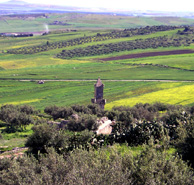 |
How to get there from Tunis?
The site lies about 106 km southwest of Tunis, and is reached by the GP5 road (linking Tunis to the town of Kef) and soon, by the Tunis-Oued Zarga motorway up to the village of Teboursouk.
 |
The vestiges come into view from afar with the façade columns of the temple of Baal-Hammon Saturn restored to their upright position after restoration work carried out at the beginning of the last century. Since then they have marked the site’s topography, dominating the wadi Khalled valley from their newfound height.
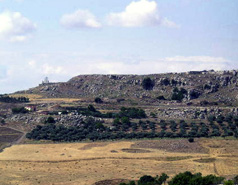 |
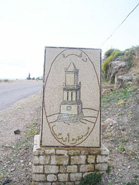 |
Discovering the site
Already visited in 1631 by Thomas d’Arcos, a provençal of Spanish origin captured by pirates and sold to a rich Tunis merchant before buying his freedom back and converting to Islam, Dougga, which, at that time was a small agricultural village, was to become from the early XVIIIth century onwards, one of the Tunisian archaeological sites most frequently visited by European travellers. Research work, begun immediately after the French protectorate in 1881 and conducted since at a more or less steady pace, has so far led to the excavation of only about a third of the site. A great many monuments dating to different periods and of a wide variety have been excavated. Many are unique in their kind making Dougga the outstanding site that it is.
The site’s potential
The vestiges of this city, which at the time of its greatest expansion contained an urban population estimated to have been about 5000 habitants (10.000 counting those living on its tiny territory), cover a total surface area of about 70 ha.
Dougga can boast an epigraphic collection of exceptional value. With more than 2000 Libyc, Punic, neo-Punic, Greet and Latin inscriptions, this collection has made a decisive contribution not only to deciphering Libyc script but to the knowledge of Numidian social organisation and municipal life, as well as to understanding some hitherto obscure aspects of the history of Rome’s colonial policy and the municipal organisation of its provinces
Added to this is an important collection of Roman period mosaics, twenty or so of which are either on display or conserved in storage in the National Bardo Museum in Tunis. These mosaics figure various themes taken from daily life (performances, drinking, gods, goddesses…) as well as a few mythological episodes and help to imagine and gain a better understanding of the Thuggenses’ mentality.
Development of the site: The presidential project for a National Archaeological Park
The 21 July 1991 is a landmark date for Dougga, for on that day, in Carthage, during a cabinet meeting chaired by the head of state, the decision was taken to turn the site of Dougga into a National Archaeological Park.
This decision sought to achieve three major objectives:
·Ensure the durable protection and conservation of this flagship site and of its natural environment.
·Give new impetus to and develop the scientific study of the site
Develop the site to make Dougga a principle feature of cultural tourism and a vector of sustainable development.
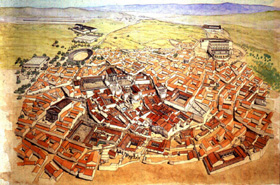 |
History
Thugga (Dougga), from a Numidian town to an African-Roman city
Given that it was not as important as Carthage, literary sources made no mention of the foundation of Thugga. It was born in total anonymity on the flank of a plateau dominating the rich wadi Khalled plain, where centuries later, the great artery of the Roman province was to pass to link Carthage to the Roman African Army’s successive headquarters ((Ammaedara / Haïdra in Tunisia, Theveste / Tebessa and Lambaesis / Tazoult in Algeria). The northern side of the plateau is abrupt while to the west it slopes down gently, and to the southeast the slope becomes steeper with a difference in level of more than a hundred meters over a distance of no more than 750m. Although the date of the town’s foundation is not yet known, it could not have been after the end of the VIth century BC, as ongoing research and prospecting in most of the ancient cities in the middle valley of the Majrada (ancient Bagrada) and in the Tunisian High Tell are beginning to confirm.
First capital of the Massyle kingdom?
Diodorus of Sicily (Bibliothèque historique, XX, 57, 4.) tells us that at the time of Agathocles’ expedition to Africa Toccaï / Thugga, one of the foremost inland cities taken by Eumachos, lieutenant of the tyrant of Syracuse, was a ‘city of a fine size”. Written by a Greek author, this description albeit laconic is sufficient to suppose that the urban centre must have been one of the most important of the region. This importance led some modern scholars to identify it as the first capital of the Massyle kingdom. According to others, it could even have been the administrative centre of the large Punic district of Tusca, which encompassed about fifty cities according to Apppian (Roman History VIII, cfr. S. Gsell, Ancient History of North Africa, V, p. 263-264.).
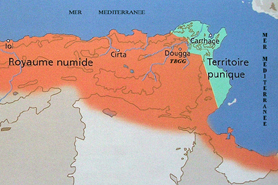 |
State of Knowledge of Numidian vestiges:
Knowledge of the urban plan of the Numidian centre provided by the present state of excavations and studies is as follows:
·vestiges of a religious nature
·different types of funerary monuments
·and vestiges of dwellings.
Picture of the site plan
Religious vestiges:
Baal Hammon Sanctuary
Traces of a religious construction dedicated to Baal Hammon were found under the levels of the Roman period temple of Saturn (monument n°1 on the plan) to the north-east of the site where the votive steles bearing inscriptions in Neo-Punic and Greek were found in the faviassae (graves), and reclaimed for use in the surrounding walls of the roman period sanctuary. Similarly, votive elements dating to the middle of the IInd century BC were also excavated, suggesting that an earlier sanctuary had been built on the spot. The first place of worship was in the form of an open-air space where sacrifices were held and where ex-votos were placed to perpetuate the memory. At the beginning of Septimus Severus’ reign (193-211 AD), the first sanctuary was filled under 2m of earth.
– Massinissa’s sanctuary:
Dedicated to the Numidian king Massinissa (148 BC) and built in 139 BC, this sanctuary (maqdes) (n°14) is situated within the precincts of the Roman period public square to the west of the capitol.
– Funerary monuments:
The funerary monuments lie on the northern and southern boundaries of the site.
To the north:
·a dolmen necropolis (n°41)
·tower tombs and bazinas (n°42).
To the south:
·the famous Libyco-Punic mausoleum (n°54).
-Vestiges of dwellings
Their remains have been identified:
– to the south-east of the forum, under the tiers of seats of the small culttheatre of the sanctuary built by the Gabinii (no9) in the early IInd c. AD, where structures of a dwelling dating to the IInd c. BC have been found;
– in the structures of the House of Dionysus and Ulysses (no27) where parts dating to the Numidian period were identified
-under the level of the house of the trifolium (no 47), pre-Roman layers of occupation have been recognized;
-similarly, in the sector of the Lybico-Punic mausoleum (no54), a monument with a circular base, built of dry stone and crowned by a corbel vault with an opening in the centre. The monument is almost totally below the level of the ancient street that runs alongside it to the east. On-going excavations have so far explored its upper part to a depth of over 5m. This monument, of which there seems to be no similar example in Numidian archaeology and whose purpose has not yet been determined, appears to be of a funeral nature and to pre-date the mausoleum. If it proves, as seems likely, to be a new type of tomb, it will confirm what the existence of Numidian period dwellings under the house of the trifolium unambiguously suggests, i.e that the mausoleum was built in an urban necropolis and not out in the middle of the countryside.
In the area of the forum, fragments of pediments from small religious buildings as well as elements of architectural decoration have been found, which must have belonged to the city’s public monuments.
In addition to this archaeological data, a large collection of Libyc, Greek, Punic and bilingual Lybic and Punic inscriptions attest to the level of cultural development achieved by the city during the IIIrd and IInd centuries BC. Amongst the bilingual inscriptions (Libyc and Punic) one, found in 1904 during excavations carried out in the south-west sector of the forum, mentions Massinissa’s maqdes (temple) built in the year 10 of Micipsa’s reign, i.e in 139 BC.It is the only dated Libyc inscription discovered so far. As for the remains of the above mentioned sanctuary generally thought to have been in the sector to the north of the forum, they have recently been located in the northern corner of this public square.
This data sheds a completely new light, suggesting that assumptions concerning the topography and the organisation of the Numidian urban centre should be revised. Contrary to the opinion held by L. Poinssot and his successors, it demonstrates that the space occupied by the town was not restricted to the upper part of the plateau alone, but extended right up to the area around the Libyco-Punic mausoleum, which was not built in the middle of the countryside but was part of an urban necropolis. Thus, during the kingdom, the town of Tocai/Thugga seems to have attained about the same surface area it covered at the height of the Roman period.
II- The Roman period: a time of coexistence
In Thugga the Roman period started in 46 BC immediately after the defeat of the Numidian king Juba 1st and the transformation of his kingdom into a new Roman province in Africa: the prouincia Africa noua. The city was not destroyed nor were its inhabitants obliged to flee. Shortly afterwards, with the reign of Tiberius (14-37 AD) a community of colonists, depending on the newly re-established Roman colony of Carthage, settled on its territory. Thus, during more than two and a half centuries, two legally distinct communities coexisted in the same city and on the same territory, one composed of native inhabitants and organized within a civitasperegrina and the other formed of Roman colonists organized within a Pagus. They were both to participate on an equal footing in the development and prosperity of the city. Two civilisations, the Punic-Numidian of the native population and the Greco-Latin of the Roman colonists intermingled and thus gave birth to a culture that could be qualified as «Africo-Roman». After Roman colonisation, the native population did not, in fact, renounce their life style, or their language, or their gods as if by magic. On the other hand, the new arrivals did not arrive empty handed. They brought their language, Latin, become the official language of the province, their Greco-Roman gods, their life style and their town planning. The urban landscape was progressively redesigned. New types of monuments, hitherto unknown to Punic or Numidian architecture, were introduced, as for example the monuments devoted to performance and leisure (theatre n°5, circus n°40, public baths n°21, 48 et 58….) Greco-Romantype temples (n°10, 12…) or the arches ( n°37 et 49), not to mention the aqueduct (n° 36), public cisterns (n°35, 38 et 56) or the nympheums ( n°33 et 55) and other public fountains (n°6 and 46). During more than two centuries, the city was to live to the ceaseless rhythm of construction sites funded by the wealthy families from both communities in their vain competition for honours… While maintaining a thoroughly Numidian town plan, Thugga was being endowed with an array of Roman style monuments. In this respect, it constitutes a representative example of a Maghrebi city ruled by Numidian kings during the first centuries of the Roman Empire.
The creation in 205 AD of the municipium and the promotion of the city to the rank of a Roman colony in 261 AD marked a decisive phase in the closening of ties between the two communities already well under way and crystallized by the building boom of monuments adorning the city. In fact, the inequality of legal status between the two communities was progressively bridged by the granting of Roman citizenship on an individual basis to the richest and most influential members of the native community as well as the many mixed marriages that must have taken place, contributing significantly to mingling the two populations.
Thuggareached the height of its prosperity under the reign of the Severan dynasty (193-235 AD) -235 après J.-C.), when the city reached its full expansion. It continued to enjoy prosperity, even if on a lesser scale, during the whole of the IVth century AD, as attested by the amount of restoration work carried out during this period. Indeed, in Thugga as in the rest of the province, this long period of time did not go down in history for its great architectural achievements. What mattered was to keep the rich existing monumental heritage in a good state of repair. This is why, with the exception or some very rare new constructions, built to express allegiance to a new master more than to meet any real need, the always generous acts of munificence consisted principally in restoration work on monuments that were beginning to show definite signs of age. This, spirit, that had almost become a second nature for the Thugga notables, did not wane with the end of Roman rule.
III- The later period:
At a point in time that must have been towards the end of the IVth c. – early Vth century AD, Thugga ceased to deserve the name of town. It began to live through a period that could be termed the ruralisation of the ancient cities of the northwest of the country. This as yet little studied process, but which is increasingly attested by archaeological evidence, affected almost all the urban centres that prospered in the region since Numidian times. It was characterized by the progressive transformation of towns into simple rural centres before turning into the poor villages they remained for long centuries, unless they were just simply abandoned
The vestiges dating to this period so far identified are:
· A funerary monument: the hypogeum (n°4) that remained in use during the IVh c.AD as attested by the many sarcophagi discovered there.
· And a religious monument: the martyrial church known as that ofVictoria (no 3) datable to the late IVth – early Vth c. AD.
Regarding the following period, i.e. the century during which Africa fell under Vandal rule (439-533), the total absence of records referring to Thugga, prevents any judgement on the state of the centre. The lack, as from this date, of any mention of the representative of the Christian community in the reports of the numerous councils of African bishops, can be taken as a clue to the regression of urban life and even to the desertion of a major part of the population. However, what is sure is that during the Byzantine period (533-698), Thugga’s role in the defensive system hastily created by the army arrived from the East, was insignificant compared to that of neighbouring towns such as Agbia (Borj Brahim), ThubursicumBure (Teboursouk) or Thignica (Ain-Tounga). The fortifications (no16) built on the order of the generalissimo Solomon enclosing the forum and the Capitol seem to have been intended as a refuge for the civilian population rather than as a camp for an army in charge of surveillance and security in the region. With the end of Byzantine rule, the little town disappeared, as it was born, in total anonymity, after having lived for more than ten centuries, without ambition and without glory. Life, however, continued amongst and over the ruins. The rare vestiges dating to this period to have escaped the shovels «trained» to stop only at the levels of the «proper period» (Early Roman Empire), suggest that organized life had not completely disappeared. Yet, to write the history of medieval Dougga, it will be necessary to wait for future excavations.
 |
The site and its territory
- Dougga and its territory: A divorce that has lasted far too long!
The history of the relations between the site of Dougga and its territory go back a long way. Indeed, to over a century ago. These relations started the day when the archaeological vestiges amongst which and over which a small rural settlement had been established for years, began to attract the interest of European explorers and scientistsand therefore became the object of study and research. The premises of what was later to seal Dougga’s fate appeared in the XVIIth century with the first explorers, and was crystallized shortly after the establishment of the French protectorate over the Regency of Tunis in 1881.
 |
 |
Its first manifestation on the site itself was the start of excavations, marking the beginning of a relationship that was more often one of conflict than of harmony between what was to become an archaeological site and its human environment.
 |
The reasons for the strained relationship that finally resulted in a clean divorce between the archaeological site and the local population can be summed up as follows:
1.First of all, the fact that the local population considered these vestiges to have no bearing on their own identity. For them, they did not attest to their history or to that of their ancestors. On the contrary, they were vestiges of another population and another civilisation, long since disappeared to which they felt no connection.
2.Then, the fact must not be overlooked that, either by voluntary sale or by forced expropriation, research and investigations developed at the expense of residential space and farmed land that had hitherto provided the population with their livelihood.
 |
 |
 |
 |
3.Finally, this progressive and inexorable dispossession, manifested most forcefully by the transformation of the small agricultural village of Dougga into an archaeological site, was not accompanied by the creation of new activities that could have provided new forms of livelihood for the population or that could have adequately compensated its loss of control over a part of the land. On the contrary, this dispossession was accompanied by the introduction of restrictive legislation instituting legal authority and limiting the right of enjoyment in the areas remaining under private ownership. All this was conducted with no concern to explain, or compensate or even less involve the local population
Thus, for decades and until recently, what we had was an archaeological site cut off from the outside world coexisting with a local population whose back was resolutely turned upon it, supremely ignoring it, except when an opportunity arose for occasional or seasonal jobs.
As can readily be understood from the above, the integration of the site in its territory is almost non existent and the opportunity for direct or induced professional activities it may have generated are very slight compared to the potential in this respect. This situation is all the more regrettable because both the intrinsic value of the cultural property and its socio-economic context offer all the conditions for applying and validating on a real scale the approach that considers cultural heritage in general and archaeological heritage in particular, as a lever for sustainable development, particularly in underprivileged areas.
- Mokhôla, a Roman era pagan divinity who became the Dougguis’s patron saint.
Who was «Lella Mokhôla» ?
According to the local population, it is said that Mokhola was a tall and sturdy virgin. She had very white skin and very black hair. When she arrived in Dougga, she was dressed in green with a red headdress. She came from Morocco a long time ago with her brother and several companions. She stopped near Bab-er-Roumia (Severus Alexander’s arch on the western edge of the village) to rest and when she wanted to leave again, the inhabitants of the place forced her to remain. After consulting God, she decided to stay in Dougga in the specus of the Roman aqueduct of Ain-El-Hammam ( at the exact spot where the aqueduct arrives at the Ain-El-Hamman cisterns next to the Severus Alexander Arch) that she leaves each year to go to Mecca.
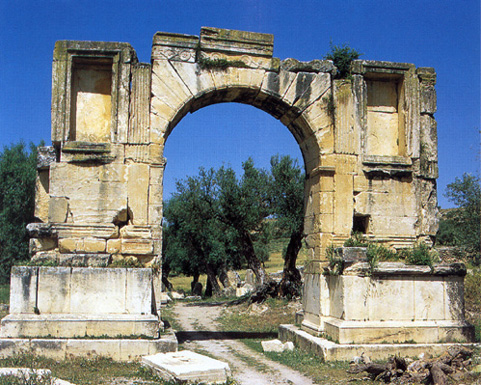 |
 |
 |
- Her miracles
Her miracles are numerous. Indeed, she is reputed to:
· Make it rain
· Cure the sick
· Find a husband or a wife for those who are single
· Help school children and students to succeed in their studies.
· Ensure the migrant returns safe and sound
· Appear to prisoners in their cells or to army conscripts when they are far from home.
· Render the earth, women and animals fertile
Such is the belief of Dougguis in their saint. The cult vowed to the saint continues even after the “divorce” between the archaeological site and the local population, which for decades now has been living in Dougga-El-Jadida, a few kilometres to the south. It is expressed in different manners, either collectively, within the family or individually.
The place of worship
The place of worship is the arrival point of the Ain-el-Hammam Roman aqueduct in the cisterns of the same name. It is said that her tomb is in the specus of the aqueduct.
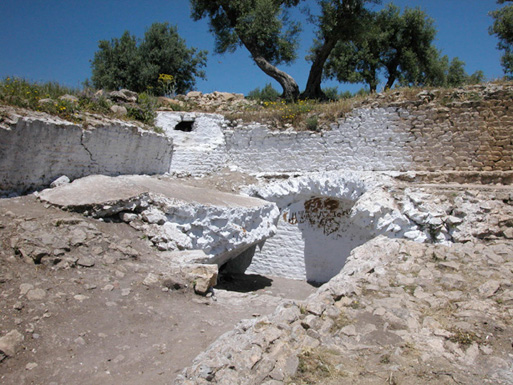 |
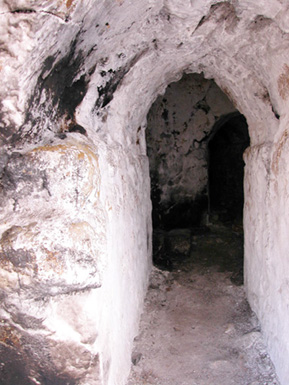 |
The«Ouakil» was responsible for organizing the cult.
His tasks were to:
· Attend to the lighting either with candles or oil lamps
· Ensure the place was perfumed with incense and benjamin (resinous and aromatic substances «bkhour, jawi, wchak we ded»)
· ensure the cistern wall was lime washed
· collect donations in money from the faithful for maintenance and if the sum was substantial it would be used to buy a cow to be sacrificed during a grand procession.
Rites and practices
Collective rites and practices
«The zarda», annual celebration
Once a year, in the spring, the Aïn-El-Hammam cisterns and the area around the Severus Alexander arch come alive with a colourful crowd, on the occasion of «Lella Mokhola’s» «zarda». This is well-established ceremony of a religious and sacred nature amongst the inhabitants of Dougga and its surrounding region.
 |
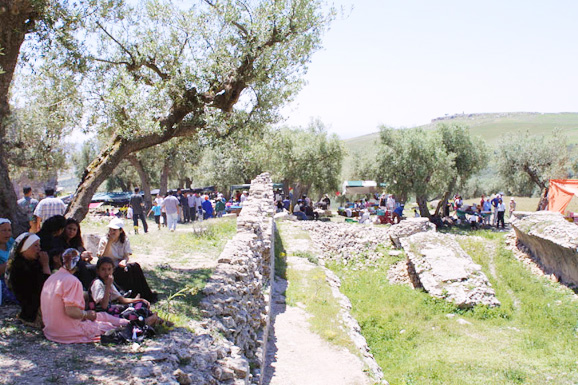 |
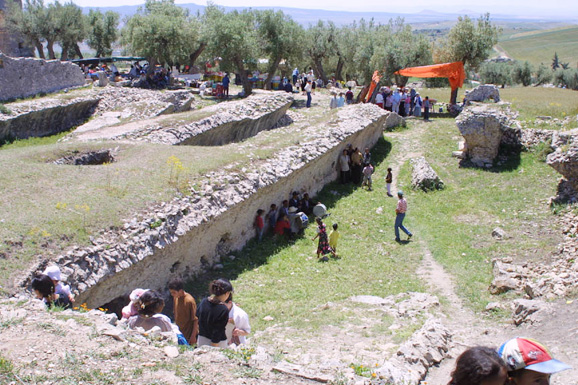 |
Preparations for this celebration awaited impatiently by all the faithful, starts with the collection of donations of to buy an animal for sacrifice : a black cow, as it is said that the first victim offered in sacrifice to this saint was a black cow and the choice has now become customary. If the sum collected is greater than the price of a cow then two or even three might be purchased. And if there is still some money left over then it is kept for the following year. The price of a cow varies from one year to the next, but costs between 700 and 1000 dinars (500-700 euros). On the eve of the “zarda’ the victims are led into the cisterns because the faithful believe that “Lella Mokhoula” leaves her refuge during the night and pours oil on the head of the beast to be sacrificed the next day.
On the day of the celebration, always a Friday, all the faithful are present and even those who live far away. Men, women, children, school children, students, flute players and drummers and especially peddlers. For the latter, the «zarda» is one of the best days for business. They reach the spot early to lay out their wares that consist of children’s toys, sweets, sandwiches, soft drinks, clothes, candles, henna, incense, benjamin..
 |
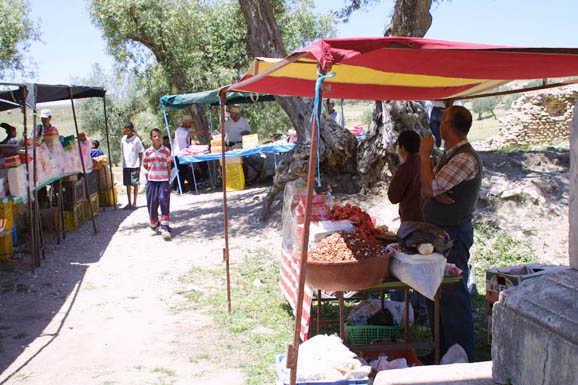 |
 |
 |
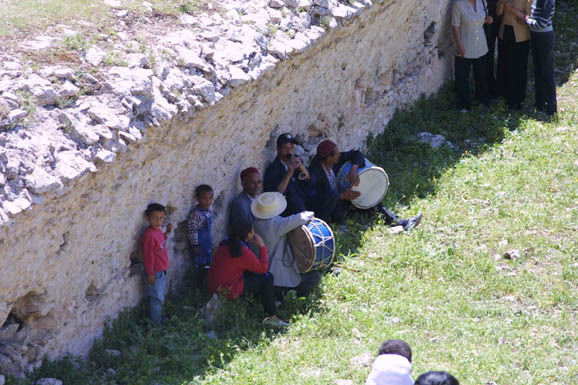 |
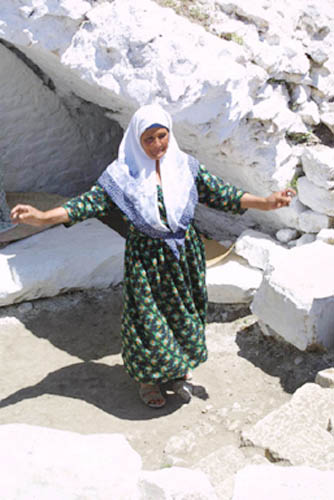 |
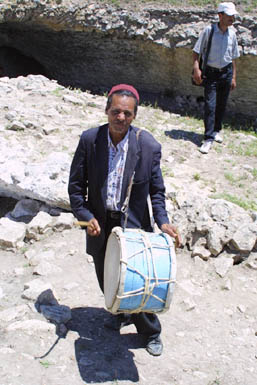 |
Once the offering has been slaughtered, the meat is shared out and distributed equally amongst the donors. A competition then takes place between the women to see whose couscous dish is the most finely garnished. At about 1 p.m., the dishes are ready and are displayed near the sanctuary to feed the poor and all those present: everyone tastes the “baraka and smat”. People sit in circles of five or ten in the middle of which a large dish of couscous is placed with as many pieces of meat as there are people around the circle. This used to take place when the faithful still lived on the site. Nowadays, it is reduced to the distribution of pieces of meat to the poor. Couscous is no longer eaten collectively. Each family prepares their own and eats it at home.
 |
The celebration was an occasion for the faithful to ask «Lella Mokhôla” to fulfil their wishes, to help and bless their undertakings. They brought the saint candles; henna, incense and young girls inscribed the name of their sweetheart or fiancé on the sanctuary wall. To chase away the evil eye and as a prophylaxis measure, out of superstition, women especially, drew a fish and the five fingers of the hand known as the “hand of Fatma” with henna or blood of the victim.
 |
 |
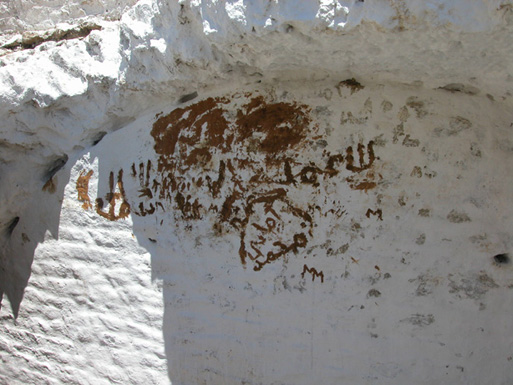 |
- In periods of drought
It was customary amongst the Dougguis during periods of drought to go and pray as a group to “Lella Mokhola” beseeching her to bring rain, saints being considered as the closest to God. They went to the spot carrying the saint’s banner. Prayers were in the form of repetitive chants and drumming. Generally, it did rain!!
Individual rites and practices: the occasional and special «ziaras»
These were practiced year round and consisted of individual or family visits, «ziaras». The object of the visit varied from one faithful to the other but the occasions and circumstances were generally the following:
Circumcision
The mother brought her son to «Lella Mokhôla» usually on the day of circumcision but before the act, unless they lived far away. She slit the neck of a cock in front of the sanctuary that she took back with her to eat at home and left the guts, the feet and the head in the sanctuary as «baraka». The same gestures are always repeated and candles, henna, and incense are brought……..
Marriage
Naturally, the wish to marry expressed by single men and women precedes the choice of partner. They return once the wish has been granted and as soon as the proposal has been made, i.e before the engagement, to thank “Lella Mokhola” and if all goes well until the wedding they go to the sanctuary to ask the saint to bless the union to protect it and ensure its success.
The bride goes there on the eve of the first day of the week preceding her wedding, wrapped in the saint’s banner: “sanjak”. She goes with her friends and her family who accompany her with youyous and songs.
Fertility and cure:
In cases of infertility, men and women pray to the saint to be cured and to have children. Sometimes people who have only had sons pray to have girls or the contrary. The same applies to illness. In short, the Dougguis make all sorts of wishes to their patron saint. Almost all the faithful promise to kill a cock each year if the wish is granted. And out of fear, they hold their promise and sometimes slit the throat of two or more cocks out of generosity.
Her wrath:
It is frightful. According to her faithful, Mokhola:
· causes the death of thieves who does not amend their ways, despite her warnings,
· and of the woman who insults her;
· she blinds the jackal who has drunk the oil of her lamps”
Cult of a pagan nature:
It is thanks to a dedication commemorating the construction of the Roman aqueduct known as that of Ain-El-Hammam at the expense of the civitasAureliaThugga and dedicated to the protection of the emperor Commodius (180-193 AD) that the connection was made between the place name of the Moccolitane spring mentioned in the inscription and Mokhola. The constructions dates to the African proconsulate of Marcus Antonius Zeno : 184-187 AD and the text is as follows:
[pro salute Imp(eratoris) Caesaris M(arci) Aurelii Commodi Antonini
Aug(usti)] Pii, Sarmatici, Ge]rmanici max[i]mi, Britanici, p(atris)
p(atriae) civitas Aurelia Thugga
[a]quam con[duxit e fonte [M]occol[i]tano, a milliario septimo, [sua]
pecunia induxi[t], lacum fecit, […] M(arcus) Antonius Zeno
proc[o(n)s(ul) Africae dedi(avit)].
 |
«For the protection of the emperor Cesar Marcus Aurelius Commodius Antoninus Augustus, Pious, victor of the Sarmates, victor of the Bretons, father of the homeland, the civitas Aurelia of Thugga brought the aqueduct form the spring Moccolitane, it built it at their cost from the seventh mile, built a nymphaeum (with its ornamentation?); Marcus Antonius Zeno, proconsul of Africa made the dedication»
After a thorough study of the inscription, it has been demonstrated that the cult of this saint is of pagan origin. It started with the arrival of water from the Moccolitane spring (=Ain-El-Hammam) to Thugga between 184-187. Indeed, the name Mokhoula has no meaning in Arabic. It can only be derived from an ancient term, which in turn perpetuates an inheritance from Antiquity. The very act of offering sacrifices in sanctuaries is a pagan tradition.
The cult of women saints is widespread in Tunisia. In Tunis, for example, there is «Lella Manoubia» or «Es-Saida manoubia», Lella Arbia» and «Lella Salha» The difference with these, until proved otherwise, is that in the case of our saint Mokhola, the rite has proved more ancient, dating back, in fact, to the Roman era. And in the words of the historian Azedine Beschaouch writing on the subject: «African Romanness was able to hide in the folds of popular memory and it can still reveal itself from time to time.» The important thing is that today the Dougguis still go to the sanctuary to pay tribute to their patron saint Mokhola.
Numidian vestiges
 |
The monuments belonging to the Numidian urban centre so far identified in Dougga are spread over an area stretching from the north to the south of the site, covering about the same surface area as the city during Roman times.
The religious vestiges
-Baal Hammon sanctuary:
In the ground under the courtyard of the temple of Saturn (no 1 on the plan) to the north-west of the site, investigations revealed the remains of an older sanctuary where the great god of pre-Roman times, Baal Hammon, later to become Saturnus in Roman times, was venerated. Votive steles bearing inscriptions in neo-Punic and Greek were found in the favissae (graves) and reclaimed for use in the surrounding walls of the Roman period sanctuary. Votive artefacts datable to the mid IInd century BC were also excavated.
This place of worship was in the form of an open-air area where sacrifices were conducted and where ex-voto were laid to perpetuate the memory. At the beginning of Septimus Severus’ reign (193-211 AD), the early sanctuary was filled under 2m of earth.
– Massinissa’s maqdes(sanctuary) :
Dedicated to the memory of the Numidian king Massinissa (148 BC) and built before 139 BC, this sanctuary, (maqdes) (n°14) lies within the precinct of the Roman era public square to the east of the capitol.
Built on a rectangular plan measuring 14,65m long by 6,30m wide, with quadrangular stone blocks on a moulded wall base, it is similar to the Numidian sanctuary of Simitthus built under the reign of Micipsa (148-118 BC).
Before it was identified, the sanctuary was known only from a bilingual, Punic and Lybic inscription found in 1904 in the southwestern sector of the forum and conserved since in the National Bardo Museum. Dated precisely to year 10 of Micipsa’s reign (139 BC.), it commemorates the construction by the leading citizens of Thugga of a maqdes (sanctuary) to the deceased Massinissa.
The identification of the monument on this spot constitutes archaeological evidence attesting to the fact that the forum quarter did not wait for the arrival of the Romans to become urbanised and was already the agora of the city during the Royal era.
Funerary monuments:
The funerary monuments dating to Numidian times lie on the site’s northern and southern boundaries.
– The dolmen necropolis (n°41)
Located to the northwest of the city, the necropolis is made up of dolmen type graves, of tower tombs and bazinas.
The dolmens:
This type of funerary monument is a sort of coffer open on one side and composed
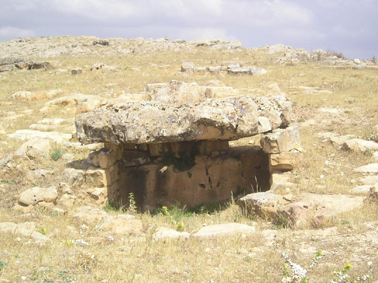 |
of three slabs standing on edge over which rests an often huge slab serving as a lid.
In most cases these were collective tombs. Since one of the sides was open, the tomb could be used repeatedly and closed again after use by an easily removable wall of dry stones.
In addition to human skeletons, many ceramic objects, particularly modeled ceramics, were found that must have been for use by the deceased in the thereafter.
These tombs have never been dated with any accuracy. However, it is known they were used during the second and first millenary BC and continued to be used during the first century AD. They can be regarded as being amongst the oldest archaeological vestiges known so far in Dougga.
Recent excavations have shown that in addition to the dolmens, known for some time now, the necropolis also contained tower tombs and tombs of the bazina type.
Tower tombs (n°42 ex Numidian walls )
A newly conducted thorough investigation, with a detailed survey and tests, has revealed that what had previously been identified as two towers belonging to the Numidian wall were in fact two rectangular plan tower tombs.
Bazina type tombs
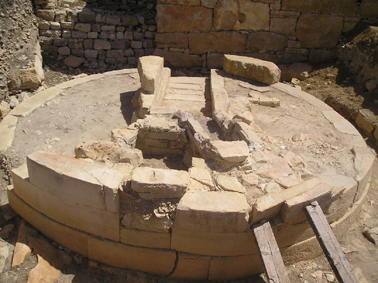 |
Numidian grave? (n°53):
Located on the southern edge of the city and in the eastern corner of the anonymous temple II (no 52) the monument is still an enigma. It has been attributed a funerary nature, deduced from the topographical context in which it lies. Shaped like a truncated cone, the monument must have been largely buried. It is built of dry stone in the form of corbelling. The ceiling is a sort of dome with an opening in the middle closed by a monolithic stone slab.
The Libyco-Punic mausoleum (n°54)
Datable to the III-IInd century BC and located to the south-east of the city, this mausoleum, also known as Atban’s mausoleum, was most probably a cenotaph dedicated to king Massinissa. From the height of its 21m, it remains one of the rare surviving examples of what specialists agree to term « Royal Numidian architecture ».
 |
Resting on a pedestal of five steps, it is three stories high.
– a lower level decorated at the corners with pilasters containing the funerary chamber. Access to the later is through a window situated on the northern face, which was closed with a slab that has since disappeared. The three other faces are each adorned with a decorative window.
– a middle story resting on three steps and composed of three rows of ashlar, an architrave and an Egyptian gorge. It is ornamented with fluted Ionic columns. The northern and eastern faces are adorned with windows formerly closed with slabs.
– An upper level resting on steps interrupted at the corners by pedestals decorated with horsemen. A low relief representing a quadriga driven by two figures adorns each of the faces. The monument is crowned by a pyramidion flanked at the corner by four statues of winged females and surmounted by the statue of a lion seated on his hind legs.
In 1842, the monument was almost completely demolished by Thomas Read, the then British Consul in Tunis, in the process of removing the famous bilingual Libyc and Punic inscription that used to be on the left of the lower story window and which is now in the British Museum in London.
Thanks to work carried out between the years 1908-1910, the mausoleum was restored. But before its restoration, various explorers made several sketches of the monument. The first was by Bruce in 1765 and consists of a schematic drawing of the northern and eastern faces of the lower and middle stories. In 1885, Henri Saladin drew the southern face of the monument with its three stories attempting in particular to reproduce the decoration
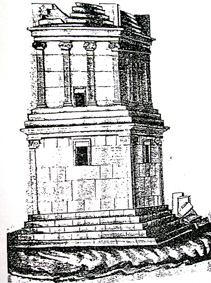 |
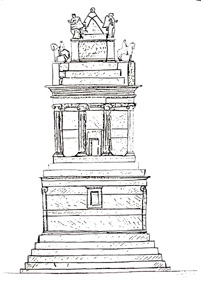 |
 |
Roman vestiges
 |
 |
 |
- Square of the Wind Rose ( n°9 on the above plan )
During Roman times the square was known as the area macelli, “Market Square”. Its paving is carved with a Wind rose, a sun dial indicating the12 winds, hence the name now given to the square. Its plan is unusual, for instead of being rectilinear, the portico bordering its eastern side is in the shape of a hemicycle so as to hide the oblique line of the temple of Fortune’s façade which, since it predates the square, was not properly integrated into the new setting. It was probably built at the expense of the Pacuvii, donors of the two monuments bordering it to the north and south, i.e the Temple of Mercury and the market.
 |
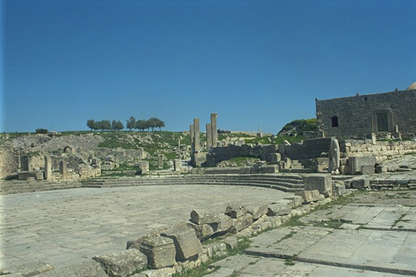 |
- Templeof Mercury(n°10)
This temple is dedicated to the god of trade and merchants. It stood to the north of the Square of the Wind Rose, adjoining the Capitol’s eastern wall and facing the market. It was built under the reign of Commodius (180-193 AD) at the expense of Quintus Pacuvius Saturus and his wife Nahania Victoria in execution of their son’s will, a soldier who died in action. Access is by means of a flight of four steps giving onto a portico with ten columns beyond which lie three cult chambers. The middle one and the largest, is rectangularwhile the other two are semi-circular. Sarcophagi were found in the eastern cella, dating to the later Roman period, as well as elements belonging to oil works going back to the Vandal period.
 |
- The market (n°11)
This macellum lies south of the Square of the Wind Rose and is one of the most ancient markets of Roman Africa.. It was built between the 25 January and 13 October 54 AD at the expense of Marcus Licinius Rufus, a rich and powerful patron of the Thuggapagus. It was almost entirely razed to the ground when the Byzantine fort was built. Preceded by a portico donated by the same donors as for the temple of Mercury, it is composed of an open-air courtyard bordered to the east and to the west by ten shops on each side. An apse that has lost its floor and that must have housed the satute of Mercury, “genius of the market”, occupies the southern side.
 |
- The Capitol (n°12)
This temple is devoted to the cult of the protective triad of Rome : Jupiter, Juno and Minerva. It was built at the expense of Lucius Marcius Simplex and his son Lucius Marcius Simplex Regillianus in 166 or 167 AD. It is fronted by a paved platform that served as a courtyard for the faithful.
A staircase leads up to it giving onto a portico formed of four columns on the façade and two columns round the side. Beyond this is the cult chamber, a large rectangular room (13mx14m), with three niches decorating its end wall. The highest of these, in the middle, contained a colossal statue of Jupiter seated and the other two those of Juno and Minerva. The tympanum on the pediment is adorned with a relief representing a man being carried away by an eagle, symbolizing the apotheosis of emperor Antoninus Pious (138-161) AD).
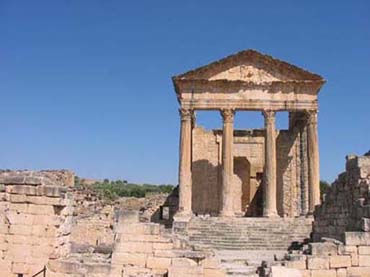 |
- The forum (n°13)
Rather small in size (38,5m x 24m), the forum is a square surrounded by porticos on three sides. It was paved during the last year of the reign of Tiberius (14-37 AD) at the expense of a rich member of the pagus. It was the centre of the city’s public and administrative life, where, by erecting statues, the city honoured its deserving sons and paid tribute to its rulers.
 |
- The temples
Templeof BaalHammon-Saturn (n°1)
This temple, devoted to the supreme god of ancient Africa, occupies a platform to the north east of the site. Built in 195 AD, under the reign of the emperors Septimus Severus and Clodius Albinus, it faces east and is composed of three parts:
· a vestibule
· an open air courtyard surrounded by porticos
· and three chambers (cellae) that contained one or several divine statues and cult objects.
 |
 |
 |
Several cisterns were built under the courtyard and portico floor to catch rainwater from the terraces and courtyard. Investigations were made in the latter’s subsoil revealing the remains of an older sanctuary devoted to the worship of Baal Hammon, the great god of Punic-Numidian Africa , who became Saturnus during Roman times
Temple of Neptune? (n°2)
This is a small and still anonymous sanctuary lying not far to the west of the Baal-Saturn temple. It was built against the cliff, facing easterly and thus overlooked the wadi Khalled valley.
It was entered by a flight of three steps that gave onto a narrow portico preceding a small cult chamber. A niche that used to contain the statue of the divinity is dug into the cella’s far end wall.
Epigraphic discoveries made in the surrounding area suggest that the sanctuary might have been devoted to the cult of Neptune, god of the sea, and in Africa especially, god of springs.
Temple of Augustan Piety (n°7)
This small temple was most probably built in the late lst century AD, in execution of the will of a certain Caius Pompeius Nahanius on land he owned.
It lies to the east of the Square of the Wind Rose. Access is by a side stair located on the western side. It consists of a vestibule and a small apse raised on a podium
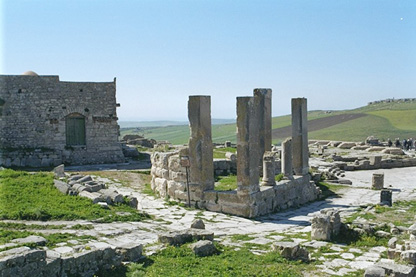 |
 |
- Temple of Augustan Fortune, Venus Concordia and Augustan Mercury (no8)
This rectangular temple, with an easterly orientation, stood to the east of the Square of the
Wind Rose, behind the temple of Augustan Piety. Of the building, all that remains is a fine base wall of large blocks with rustication and the vestiges of a black and white mosaic datable to the first half of the IInd century AD.
It was built under the reign of Hadrian (117-138 AD) at the expense of the pagus and the civitasQuintus Maedius Severus in his name and in that of his daughter the perpetual flamen Maedia Lentula.
Temple of Mercury(n°10)
(Hyper lien Quartier du forum) (Hyperlink to the Forum Quarter)
The Capitol (n°11)
(Hyper lien Quartier du forum) (Hyperlink to the Forum Quarter)
The Pagan chapel (n°15)
This is a small religious aedicule built on a podium. It faces west and can be assigned to the lst century AD.
It is reached by a flight of two steps with the lower part of the altar still embedded into them. Two columns used to hold up a pediment at the entrance of the tiny room where the statue of the divinity stood on a masonry base of which only the foundations remain.
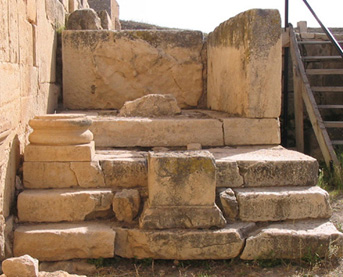 |
 |
- Templeof Tellus(n°18)
This temple is devoted to the goddess Tellus and was erected on the site of a private house. First built during the last quarter of the Ist century AD, the sanctuary was rebuilt in 261 AD (the year Thugga was promoted to the rank of Roman colony) at the expense of the perpetual flamen Botria Fortunata.
The sanctuary is not very large and is reached from the street by a stair of three steps. It consists of a courtyard surrounded by a peristyle raised by a step and of three cellae , the middle one ending with a straight wall into which three semi-circular niches were dug.
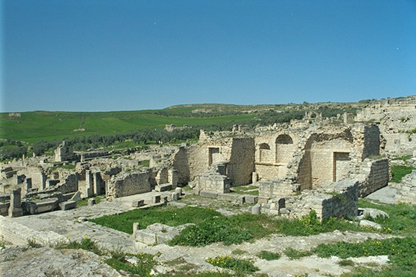 |
- Religious complex of the Gabinii(n°22)
This complex is composed of two temples (A and B) dedicated to Concordia, Frugiferi and Liberi Patris. It was built on land belonging to Aulus Gabinius Datus and his son Marcus Gabinius Bassus and at their expense. It stood to the southeast of the forum and to the north of the Caracalla Baths.
TempleA:
 |
The building is composed of a cella preceded by a pronaos, built on a high podium reached by a flight of seven steps after crossing a small courtyard.
Temple B:
It is a temple composed of a large area surrounded by porticos and five cellae opening onto the northern gallery. The central cella, larger than the others, ends in an apse where the cult statue must have stood.
Downhill from the temple lies a small theatre where ceremonies linked to the cult of Liberi Patris must have been performed. A door in the southern wall led into the building.
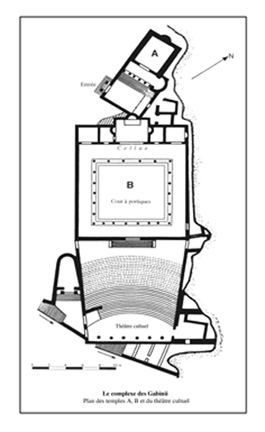 |
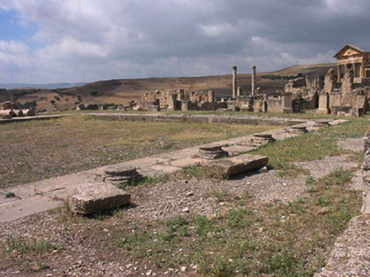 |
- Anonymous sanctuary III (n°23)
Facing southwards, this small sanctuary was built into a vacant space between the Caracalla baths and the cult theatre
A flight of four steps leads up to it and gives onto a pronaos adorned with two columns and which precedes a trapezoidal shaped room with an apse in its end wall to contain the statue of a divinity.
Sanctuary of Minerva (n°28)
This building lies downhill from the House of Dionysus and Ulysses. It was built in execution of the will of a patron of the civitas Quintus Vinnicius Genialis, at the end of the lst century AD and has a northeasterly orientation. It is composed of a large rectangular area and of a small apse located to the west where Minerva’s statue was placed.
The cult of this goddess seems to have been particularly popular with the inhabitants of Thugga as another temple was also devoted to her in the northern part of the site.
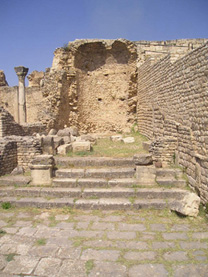 |
- Sanctuary of Minerva II (n°39)
This temple was built under the reign of emperor Antoninus Pious (138-161 AD ) at the expense of the priestess of the imperial cult Iulia Paula Laenatian.
Facing southeasterly, it consists of a large rectangular court surrounded by porticos on three sides and of a cella that was preceded by a no longer existing portico. Monumental stairs lead to the cella built on a high podium and containing rooms that were entered through side doors.
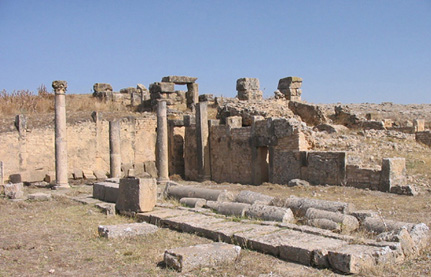 |
- Anonymous Temple I (n°30)
Located to the south-west of the forum, this monument, better known as Dar Lachheb (=the house of Lachheb) was built in 164-166 AD under the joint reign of emperors Marcus Aurelius and Lucius Verus.
A door, today still in an excellent state of conservation, gave access to a rectangular court bordered by porticos on each of its long sides. This courtyard could be the area of a temple whose cella , that lay to the south, has disappeared.
 |
- Temple of Caracalla’s Victories (n°32)
Situated in the southwestern quarter of the forum, a short distance to the west of the anonymous temple known as Dar Lachheb, this sanctuary was built on very steep terrain requiring major terracing work. It is limited to the east by a house known as that of Venus and to the west by a street that runs down towards the quarter of the Ain Doura Baths.
This relatively large podium temple, 14,20m long by 14,20 wide, faces west and was built at the far end of a courtyard, along its entire width
Access is through a side door opening near its western corner, reached by a flight of three steps giving onto a paved courtyard. The latter is dominated to the north by a large rectangular room, the cella, preceded by a portico reached by a monumental staircase.
(Scientific file)
Temple of Juno Caelestis (n°34)
Dedicated to the heir of the great goddess of Punic Carthage, Tanit, companion to Baal Hammon, this sanctuary is one of the best conserved temples in Dougga and because of its plan, one of the most original in Africa.
It is situated on the western edge of the site in the middle of a necropolis, a few dozen meters west of the arch of Severus Alexander. Facing southwards, it was built during the reign of Severus Alexander (222-235 AD). It was composed of a peripteral sanctuary raised on a high podium and preceded by a stair of eleven steps. It was built in the middle of a closed, semi-circular courtyard, a very unusual shape in Roman African religious architecture.
Scientific file
Temple of the God Sol (n°43)
This small rectangular shaped sanctuary gives onto an ancient street linking the quarter of the Ain Mizeb cisterns and the Temple of Minerva II to the street of the temple of Augustan Piety.
Devoted to the cult of the god Sol, it was built (or more likely restored) at the end of the IIIrd c. AD.
Facing westwards, it is reached by a flight of four steps giving onto a narrow vestibule preceding the cult chamber
A podium partly wedged into the cella’s end wall, that must have partially surmounted a no longer existing niche, served as a base for the divinity’s statue
 |
- Anonymous Temple IV (n°44)
This sanctuary stood north of the temple of Mercury. Facing west, it was built on a podium and reached by a stair of eight steps leading onto a narrow pronaos The cella in ruins, was built on a square plan.
 |
- Anonymous Temple known as the temple of Pluto (n°50)
Located in the southeastern quarter of the site, it is bordered to the north by the House of the Duck and of the Seasons (n°46) and to the east by a street descending southwards.
Preceded by a courtyard that served as a terrace, the temple, built on a podium, had a huge rectangular area in which the altar, still in a good state of conservation, stood. A staircase, whose upper steps have disappeared, and that gave onto a pronaos led up to it. Beyond this lay the cella, a small rectangular chamber, with its side walls still standing 1, 30m above the ground. The 3,10m high front door is wholly conserved
Following the discovery, during excavation of the monument, of a bust of Pluto, poliad god of Thugga and its protective genius, it was suggested, as a simple hypothesis, to recognize this building as a temple to this divinity.
 |
- Anonymous Temple II (n°52)
Located not very far north of the Libyco-Punic mausoleum, this sanctuary was built on land formerly occupied by Numidian graves
Built on an irregular plan, facing east, it is composed of a courtyard surrounded by porticos on three sides and of a small sanctuary on a podium occupying the western side.
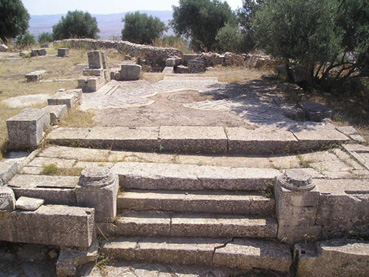 |
- The Houses
To date, 12 houses have been identified. With the exception of two dwellings: The House of the Stairs and the House of the Trifolium, all the others owe their present names to the subject of the mosaics paving the floor of either one of their rooms, or the courtyard, vestibule, or even a basin.
They constitute an exceptional archaeological ensemble, on the one hand because of the variety of their floor plans and their architectural characteristics, and on the other hand, because of their rich iconographic contribution composed of mosaics on a great variety of themes.
House of the cup bearers (n°19)
This dwelling stood to the east of the market with its entrance on the street of the Caracalla Baths. It is made up of a small courtyard paved with a geometric patterned mosaic onto which gave various rooms, one of which had a floor decorated with a mosaic datable to the IIIrd century AD, figuring two large cup bearers carrying amphorae on their shoulders from which they poured wine into the cups held out to them by two guests. On the right-hand cupbearer’s amphora, ornamented with ivy leaves, the Greek word PIE (drink) is written in Latin characters. On that of the left-hand cupbearer the word ZHCHC (you shall live) is written in Greek, spelling out two complementary wishes « Drink and you shall live ». To the left and right of the mosaic, two young waiters bring the drinkers, one, a basket of flowers, the other a small amphora containing perfume and a napkin. The mosaic is at present displayed in the National Bardo Museum in Tunis.
House of the Stairs (n°20)
Situated to the southeast of the market, this house, like the preceding one, gives onto the street of the Caracalla Baths. It is built on uneven, steep terrain, requiring the presence of many stairs to circulate between the different levels.
The centre of the house is markedly downhill from the rest and is made up of a little courtyard surrounded by porticos on two sides. In the centre, a small rectangular patio is bordered on the west by three rooms separated by thin walls while to the east it is bordered by a small portico.
 |
Two small stairs lead from the portico’s western bay to the north and west rooms on the floor above.
As for the northern part of the dwelling, a vestibule giving onto the street distributes the rooms, which are very damaged and seem to have been considerably remodelled.
 |
Other rooms, to the south east, separated from the house by a thick wall were most probably shops.
- House of the Labyrinth (n°24)
This house takes its name from a mosaic formerly adorning its vestibule and representing a geometric maze suggesting the plan of a Labyrinth. The mosaic dating to the IIIrd century AD, is at present displayed in the National Bardo Museum.
Located east of the Caracalla Baths, it is composed of a series of rooms opening into each other leading to a courtyard onto which several other rooms open, containing mosaics that are amongst the oldest ever to have been found in Dougga
 |
- House of the Three Masks (n°25)
This house owes its name to a mosaic paving one of the rooms and figuring three masks in medallions, including two of Bacchantes and one of Silenus. The mosaic can be dated to the IIIrd century AD and is displayed in the National Bardo Museum.
Located downhill from the House of the Labyrinth, it has a complicated plan due to its long history and the many modifications it underwent: the central part of the house is occupied by a row of rooms separated by very thin walls.
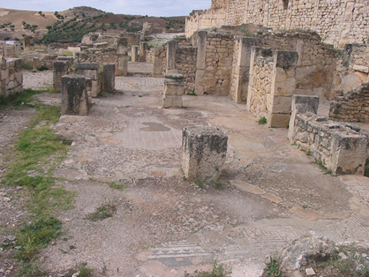 |
-
- House of Dionysos and Ulysses (n°26)
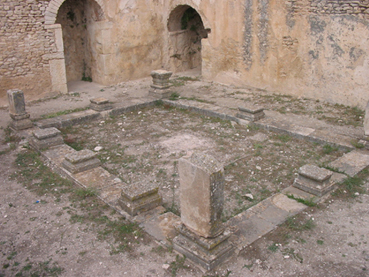 |
 |
Situated south of the Caracalla Baths, this is one of Thugga’s most sumptuous houses. It owes its name to the mosaics discovered there, one figuring Dionysos overcoming the Tyrrhenian pirates and the other Ulysses resisting the song of the Sirens. Nine mosaics were in fact discovered in the house, seven of which are exhibited in the various rooms of the National Bardo Museum and two are in storage. They can be attributed to the reign of Gallien (260-268 AD)
The house is composed of two stories including the ground floor, which opened onto the street of the anonymous temple known as Dar Lachheb and of which very little remains.
The lower floor is reached by a flight of fourteen steps leading into a large courtyard surrounded by a portico on to which open several other rooms.
 |
-
- «Omnia tibi felicia» House (May everything bring you luck) (no27)
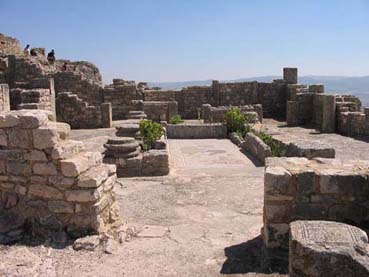 |
 |
Located south of the Caracalla Baths, the entrance to this house in on the street of the Anonymous temple or Dar Lachheb.
It owes its name to the words of welcome Omnia tibi felici (May everything bring you luck) figuring on the mosaic in the vestibule, datable to the IVth century AD and at present on display in the National Bardo Museum.
The house consists of a small courtyard with a portico below which lies a cistern. Various small rooms opening onto the peristyle occupy the north, west and eastern sides.
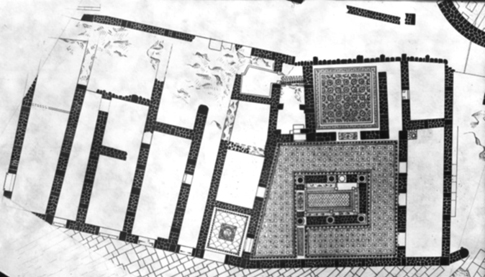 |
- House of Marsyas (n°29)
Located southeast of the Anonymous temple, or Dar Lachheb, this small house consists of three rooms. It owes its name to the mosaic that used to decorate the floor of one of these rooms, and which is now in the site storerooms. It figures various episodes of the famous myth of the shepherd Marsyas who dared to challenge the god of music, Apollo, in a contest: the discovery of the double flute by the goddess Athena , Marsyas surprising her, the musical contest between Apollo and Marsyas and the shepherd’s punishment.
 |
- House of Venus (n°31)
This house is adjacent to the temple of Caracalla’s victories of. It owes its name to a mosaic decorating the bottom of a basin figuring Venus and putti in a marine environment.
The entrance to the house is from the street separating the house to the east from the Anonymous temple. The part excavated so far is made up of a series of rooms including a triclinium, dining room, and a cubiculum, bedroom, mostly ornamented with mosaic pavements bearing a vegetal decoration.
The house underwent several modifications attesting to the long period of occupation spanning from the IInd century AD at the latest to the Vth century AD
 |
- House of the Duck and the Seasons (n°46)
Situated in the southeastern part of the site, the house is datable to the IIIrd century and is built on a very steep plot of land.
It is composed of two floors:
· An upper floor opening onto the street running down to the theatre and leading to the house of the trifolium and the Numidian mausoleum
· And the other onto the street running along the temple of Pluto and joining the one by the arch of Septimus Severus.
The two floors were connected by stairs and a mezzanine floor.
The house owes its name to two mosaics, one discovered on the upper floor figuring a duck and the other found on the lower floor representing the Genius of abundance surrounded by the four seasons.
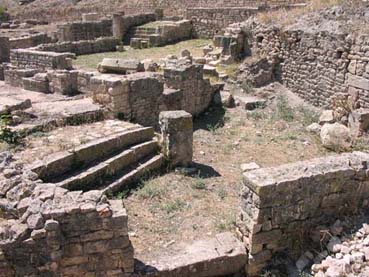 |
- House of the Trifolium (n°47)
Located in the site’s southern quarter, this house is the largest to have been excavated so far in Dougga. It consists of a ground floor, of which not much remains, and of a lower floor.
 |
Preceded by a porch with two columns overstepping onto the street, the house opens into a vestibule from which the stairs to the lower floor depart. The latter is laid out around a large courtyard surrounded by a portico and with a garden in the centre.
 |
Three doors, belonging to the largest room of the house, the oecus, open onto the western gallery. To the north, the room gives onto another large room in the shape of a trefoil.
 |
Three smaller rooms open onto the southern and eastern gallery. Along the gallery and the portico is a cistern with a small fountain on its side.
 |
- House of the Gorgon (n°51)
This house is located in the south west of the city. A porch marks the main entryway. It was built over a vast basement lit by breathing-holes at street level. The front door of the house was in the southeastern part of the house.
The vestibule was built above a cistern with vaults supported by two rows of three pillars.
The house owes its name to a mosaic in the vestibule, now displayed in the National Bardo Museum, figuring a central medallion of Perseus brandishing the head of Medusa
 |
 |
- House of Eros and Psyche (n°57)
This house, adjoining the Ain Doura Baths, has not yet been fully excavated. To date the part uncovered consists in a courtyard with porticoes onto which various rooms open, including two bedrooms or cubicula.
The courtyard presents the main features of the Italic atrium: columns surrounding an impluvium, or basin.
The dwelling owes its name to a mosaic decorating the impluvium floor figuring fishing putti and Eros and Psyche pictured in a boat: once, with one as a musician playing the flute and beating the tune with his foot and the other as a dancer, and the next with both seated and a game table on their laps.
On the western wall of the house the remains of large wall paintings are still visible.
- Water works
The site of Dougga contains a rich typology of hydraulic architecture composed of public baths, monumental fountains, nymphaeums, public latrines, cisterns and aqueducts.
Although some still remain to be excavated, these monuments can be regarded as amongst the best preserved in the Maghreb.
The Caracalla Baths (n°21)
(hyper lien m. de loisirs)
The Cyclops’ baths (n°48)
Nymphaeum of Terentius (n°33)
Overlooking a small triangular square on the edge of the street of the anonymous temple or “ Dar Lachheb”, this monumental fountain has multiple apertures arranged in segments of a circle, as attested by the frieze that adorned it, bearing a dedication to the large Aïn-El-Hammam aqueduct an this nymphaeum. The monument is part of a hydraulic complex built at the expense of the civitasAurelia of Thugga under the proconsulate of Marcus Antonius Zeno between 184 and 187 AD.
Water supplying the numphaeum must have arrived through a pipe leaving from the large Aïn-El-Hammam cisterns, the arrival point of the aqueduct, to the reservoir built behind the fountain
 |
- Fountain (n°6)
Situated along the street of the temple of Augustan Piety connecting the area of the theatre to the forum quarter, this rectangular fountain consists of a masonry block with a monumental façade adorned with two semi-circular niches from which water must have poured in a cascade. A square shaped reservoir was built behind each of the niches
 |
- Aïn-El-Hammam cisterns (n°35)
Located in the western part of the site, west of the Severus Alexander arch and north east of the temple of Caelestis, the cisterns have a capacity of about 60000m3. They were supplied by water arriving by aqueduct from the Aïn-El-Hammam springs situated 12 Km west of the city. They consisted of five reservoirs each 34m long by 5m wide. A sixth compartment, lying perpendicular to the others, served as a decantation basin.
It is here that each year in spring the Dougguis meet to organize the annual “zarda” of their patronsaint Mokhôla.
 |
- Aïn-El-Hammam aqueduct (n°36)
This is one of the best-preserved aqueducts in Tunisia. Dedicated to the protection of emperor Commodius, it was built at the expense of the civitas Aurelia Thugga under the proconsulate of Marcus Antonius Zeno: 184-187 AD and underwent major restoration as attested by a long dedication dated to the year 376 AD.
Its departure point lies in the mountain massif of Jbel Fej el Hdoum and Jbel Bou Khoubaza to the south west of Thugga at a distance of 8500m as the crow flies.
A 10m square basin was built to catch the warm water from the Aïn-El-Hammam springs before it was conveyed by underground aqueduct most of the way, to the Aïn-El-Hammam cisterns.
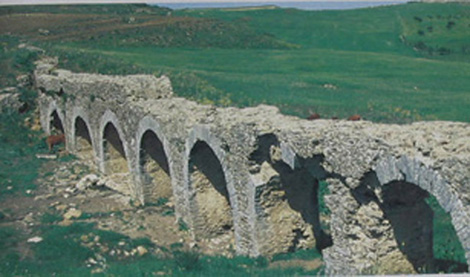 |
- Aïn Mizeb Cisterns (n°38)
With a total capacity of about 9000m3, these cisterns constituted an important reserve for the city’s water supply.
They consisted of seven reservoirs built side by side in two phases and that are each 35m long by 5m wide. An eighth compartment, lying perpendicular to the others, served as a basin for water arriving from the aqueduct.
Water arrived from the Aïn Mizeb springs situated about 200m north-west of the cisterns by an underground aqueduct that was l,60m high and 0,50 m wide. The springs are still in use today.
 |
- The conical fountain (n°45)
This fountain stood on the left side of the street leading to the Severus Alexander arch, at the busiest intersection in town, where no fewer than seven roads crossed coming from all directions.
It is surrounded by a semi-circular wall and consists of a hexagonal basin where water used to fall down a several meter high conical block that stood in the centre of it.
The great nymphaeum (n°55)
Situated west of the house of the Trifolium, this large, partly excavated nymphaeum is a sort of large vaulted exedra with a span of 8, 70m. It was supplied with water that must have come form the Aïn-El-Hammam cisterns through an underground pipeline of which no trace has yet been found.
The apse, from where the vault springs, is adorned with a cornice supporting a channel through which flowed the water brought by a pipe opening in the back wall,. A sump was placed against the outer wall of the apse.
The Aïn Doura thermal Complex
The Aïn Doura baths (n°58)
(Hyper lien m. de loisirs)
The Aïn Doura cisterns (n°56)
(Hyper lien m. de loisirs)
The Latrines of the Aïn Doura Baths (n°59)
(Hyper lien m. de loisirs)
- Monuments for entertainment
The Theatre (n°5)
With a capacity of approximately 3500 seats, this is one of Dougga’s most spectacular buildings and one of the best preserved theatres in the Maghreb. As a tribute to its perpetual Flaminate, a rich citizen of Thugga, the flamen of the imperial cult, Publius Marcius Quadratus, built this monument at his expense in 168 or 169 AD, under the joint reign of the emperors Marcus Aurelius and Lucius Verus. Situated to the northeast of the city, it possessed the features of Roman period theatres:
· a cavea
· an orchestra
· and a stage
The cavea where the spectators sat was for the most part built against the rock. It is formed of 19 tiers of seats divided into 3 stories by circulation galleries. The stories are in turn divided by stairs radiating around the orchestra that is separated from the stage by a wall of about 1 meter in height and decorated with alternating rectangular and semi-circular niches. Two stairs built against this wall lead form the orchestra to the stage.
 |
 |
- The circus (n°40)
This monument was built in 224 AD on land situated to the northwest of the city, donated in 214 AD by a rich citizen, Gabinia Hermion, as attested by the dedication.
«G[a]binia Hermiona…in her will prescribed …and the land named “the circus” she bequeathed to the republic for the pleasure of the people”
393m long with a 190 long and 6m wide spina (small wall or simple earthen mound around which ran the track ) the Thugga circus was indeed small compared to the Rome’s 600m long circus maximus or even that of Carthage which was 570m long.
The cult theatre (no22)
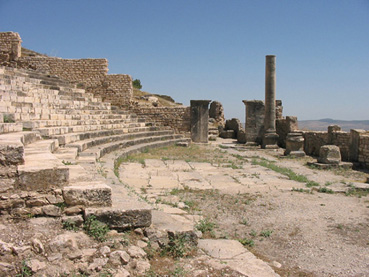 |
Ceremonies linked to the cult of Liber Patris must have taken place in this theatre. It lies downhill from the temples of Concordia, Frugiferi and Liber Patris and is accessed through a door opening in the wall of temple B belonging to the Gabinii religious complex. The door led to a stair that no longer exists but that must have led to the cavea’s upper gallery.
The building has no stage but a large orchestra in the shape of a circle segment.
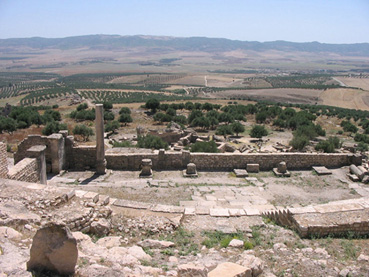 |
Several levels of Numidian era dwellings were identified under the tiers of the cavea during restoration and development work carried out on the building, thereby substantiating information provided by epigraphy indicating that the land on which the building was built belonged to a family of native origin and therefore might already have been urbanized during Numidian times.
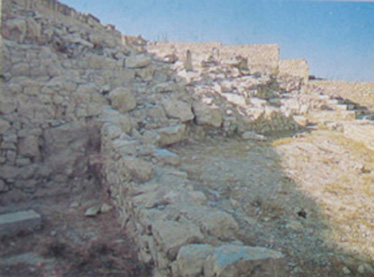 |
- The Cyclops Baths (n°48)
The monument owes its present name to a pavement mosaic formerly covering the frigidarium floor (cold room). It can be assigned to the first quarter of the IIIrd century AD and is at present displayed in the National Bardo Museum. It figures Cyclops forging Jupiter’s thunderbolt in Vulcan’s cave.
The entryway is through a large door opening onto the street and giving into a long corridor that runs along two large cisterns and leads to the frigidarium. A rectangular pool ending in an exedra extends from the frigidarium.
 |
To the left of this door lie the public latrines, consisting of a long, almost semi circular, stone bench with twelve seats. A channel gutter dug into the paving runs along the foot of the bench bringing the water required for washing.
Opposite the seats, against the cistern wall, was a small tub supplied with water from the large cisterns located on the other side of the wall.
- Les thermes de Caracalla (n°21)
-
The Caracalla Baths (n°21)
-
The Caracalla Baths (n°21)
This establishment lies southwest of the forum quarter. It obeys a symmetrical plan and was built under the reign of emperor Caracalla (212-217 après J.-C.). It ranks amongst the largest baths to be found in the Maghreb.
A large entrance door gives onto the atrium and from there a large staircase with 24 steps leads to a great entrance hall giving access to the various rooms of the baths : vestibules, apodytherium (changing room), frigidarium (cold room), elæothesium (oil storage and massage room) palaestra (exercise court), sudatoria (two steam rooms to activate sweating ), laconica (two dry heat rooms to activate sweating), caldaria (three hot bath rooms) and a tepidarium (tepid bath room).
A service basement was built below the hot rooms
 |
 |
- Aïn Doura thermal Complex
Taking its name from that of a neighbouring spring and located in the site’s southwestern quarter, this thermal complex has three main components:
· The bathing establishment itself.
· The latrines
· The cistern
- The Baths (n°58)
Built according to an upturned T plan the baths were built on a fairly stiff slope requiring considerable terracing work. To date, only the eastern part of the monument has been excavated. So far, the following components have been identified:
· le frigidarium, cold bath room flanked by four pools
· le tepidarium on the way out
· three heated rooms aligned with the tepidarium
· and a few service rooms
 |
- The latrines (n°59)
These are located to the south-east of the establishment and are built on a 25,70m diameter semi-circular plan. The seats that no longer exist rested against the semicircular wall and were sheltered by a rounded portico.
These latrines are regarded as the largest monument of its type so far discovered in Dougga
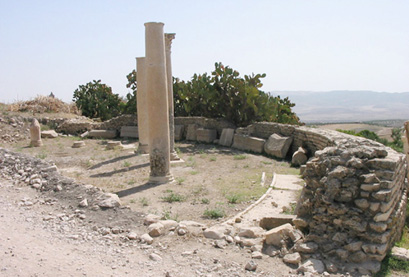 |
- The cisterns (n°56)
Overlooking the baths, the cisterns consist of three compartments separated by two rows of four arcades each. The reservoir, measuring 28,50 m long and 25m wide, had a holding capacity of about 3000m3.
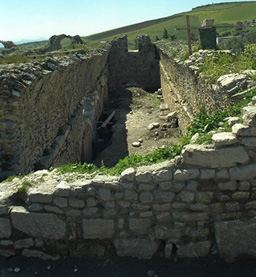 |
- Arches
Arch of Severus Alexander (n°37)
Dedicated to the emperor Severus Alexander (222-235 AD) to commemorate the privileges granted to the municipium of Thugga, the arch stands in the western part of the site near the Ain-El-Hammam cisterns. The arch has a four meters span supported by two piers decorated on the front and the back with shallow rectangular niches.
 |
- Arch of Septimus Severus (n°49)
Situated near the boundary of the site, it was built to celebrate Thugga’s promotion to the rank of municipium in 205 AD.
The arch spans five meters and is supported by piers decorated on their front and back faces with shallow rectangular niches.
An inscription was carved on each of the faces of the attic in honour, one of the emperor Septimus Severus and his wife Julia Domna, the other of their two sons Caracalla and Geta.
A road departed from the arch running down to the valley to join the main road linking Carthage to Theveste, nowadays in Algeria.
Another arch, of which nothing remains, was built at the end of the IIIrd century AD at the intersection of these two roads in honour of the emperors of the Tetrarchy.
 |
Later period vestiges
 |
Byzantine fortifications (n°16)
Located at the heart of the site, the small fort encompassed the forum and the capitol temple. It was built on the orders of the generalissimo Solomon in the 2nd quarter of the VIth century AD.
 |
 |
The fort was rectangular in shape with a rectangular tower projecting from the northern face and a small rectangular bastion on the southern face. A door opened on the south face and a postern on the north. It was built with reclaimed materials taken from adjoining monuments and even from others further away. The inside must have been filled in up to the level of the doors.
The fort seemed to have served as a refuge for the civilian population rather than as a camp for an army responsible for surveillance and security in the region.
The remains of a later date surrounding wall are still visible over a long distance and in several parts of the site. It encompassed the northern and eastern part of the city, running from the northeastern corner of the fort towards the Numidian necropolis and the area to the east of the theatre up to the lower quarter,
The Hypogeum (n°4)
Located to the northeast of the city and to the south of the Baal Hammon-Saturn temple, the hypogeum is rectangular in shape and is half buried. It was a family vault that witnessed the use, in turn, of two funerary rites: incineration and burial. A seven-step stair leads down to a door opening into an almost square room that was the burial chamber.
Niches are dug into the end as well as into the sidewalls where cinerary urns were placed. The many sarcophagi attest to the change in funerary rite from incineration to burial during the course of the IVth century AD, as a consequence of the spread of Christianity.
 |
 |
Two tombstone mosaics of two children were discovered in this hypogeum. One bears the name of the child VitelliusCrispinus and the other QuintusPapirius Fortunatianus Eusebius. They are now displayed in the National Bardo Museum in Tunis.
The church of Victoria (n°3)
Located a few meters to the east of the hypogeum, this martyrial church known as that of Victoria is the only Christian place of worship found so far in Dougga.
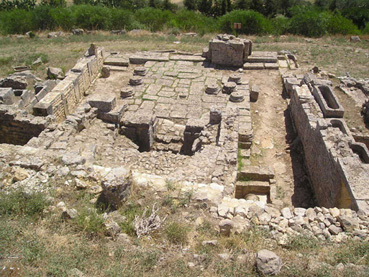 |
Datable to the end of the IVth – early Vth century AD, it was built by the Christian community in a pagan cemetery. Its plan is irregular and it is composed of a small vestibule and three aisles of unequal size. Extending from the nave, a rectangular presbyterium on a raised level has a semi-circular bench at its far end.
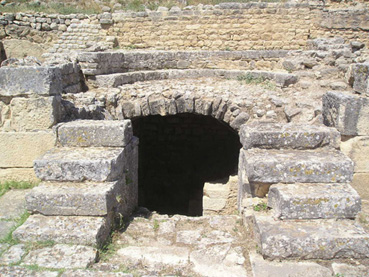 |
Extending from the side aisles is a crypt connected to two sacristies by two stairs of four steps.
Sarcophagi piled up one above the other were discovered in the crypt. Only one bears an epitaph belonging to the nun Victoria.
Exploration and collection
History of exploration on the site
The times of travellers:
Between the XVIIth century and the establishment of the French protectorate in 1881, the site of Dougga, inhabited by the descendants of the ancient Thuggenses, attracted the attention of many travellers (explorers, archaeologists, amateurs, military men…etc)
In 1631, following his voyage to Tunisia, Thomas D’Arcos, corresponding with the French scholar Peiresc, described the best-conserved monuments of Dougga, such as the capitol, the Libyco-Punic mausoleum, etc.
Early in the XVIIIth century, explorers no longer restricted themselves to simply pointing out the ruins of Dougga but started to describe them. The first was F. Ximenez, a Spanish religious belonging to the order of the Trinitarians, who in 1724, entrusted with the care of Christian captives in Tunisia, had a long stay in the Regency. In July of that year, he visited Dougga and described the monuments Thomans d’Arcos had already pointed out in his travel notes, adding the Ain Mizeb cisterns to the list.
A month later (August 1724), A. Peysonnel, a physician and naturalist from Marseille, described, in particular, the capitol, the mausoleum, the temple of Tanit-Caelestis and the Aïn-El- Hammam aqueduct that served to convey the warm waters (15°c) from the springs of the same name (Aïn-El- Hammam) to the city. These springs lie over 12 km to west of Thugga. The aqueduct is at present one of the best conserved in Tunisia.
Other descriptions were devoted to the monuments of Dougga in the accounts of XVIIIth century explorers, including those of T. Shaw, Carilos, J.E. Hebenseirt and G. Dupont who introduced the monuments of Dougga to the scholarly world.
In 1776, the British consul, J. Bruce, drew some of the monuments, including the Libyco-Punic mausoleum
Other travellers followed during the course of the XIXth century,: the count C. Borgia in 1815 and the architect F. Catherwood in 1832. The former left a detailed study of the Libyco-Punic mausoleum in his papers.
The archaeologist and British amateur, N. Davis, described the capitol, the mausoleum and the arch of Severus Alexander during his travels to Dougga, Carthage and other ancient sites in the Regency.
Author of Voyage archéologique dans la Régence de Tunis (Archaeological travels in the Regency of Tunis) published in 1862, V. Guérin, a professor of French, made known to the world of scholars other monuments not mentioned hitherto. The first description of the Byzantine citadel is owed to him.
 |
Finally, the traveller R. Playfair published drawings of Dougga’s most remarkable buildings.
Added to these were the travellers whose travel dates went unrecorded such as: L. Franck, Count Filippi, prince Puckler-Muskau , E. Pellissier, J. E. Humbert and Sir Grenville Temple who devoted long passages to the ruins of Dougga in his book “Excursions in the Mediterranean, Algiers and Tunis” in which he noted rectifications he made to some readings of epigraphic texts.
A time of exploration (1881-1956): uncovering the splendour of the past
With the advent of the French protectorate, several events occurred in succession that spurred scientific research and archaeology in Tunisia in general and in Dougga in particular. Also, the establishment in 1885 of the Department of Antiquities and Arts of the Regency, at the behest of the Committee for Historic works of the Academy of Inscriptions and Belles-Letters in 1883, heralded the beginning of a new phase in the exploration of the site of Thugga.
The time of excavations
From 1881, several explorers came to Dougga to carry out research. In 1882-1883, the French Ministry of Public Education sent J. Shmidt, commander Boyé,H. Saladin, R. Cagnat et J. Poinssot on archaeological missions to Tunisia.
Yet it was only in 1891 that the first excavations started in Dougga. Garrisoned at the time in Tebousouk (ancient Thubursicum Bure), Dr. Louis Carton (1864-1924), military physician but also an intuitive archaeologist, made the most of his stay to carry out archaeological work in Dougga. His work had the strong backing of the Academy of Inscriptions and Belles-Lettres and concentrated on prospecting the surroundings of Dougga and especially the aqueduct. On the site itself he made some investigations of the theatre and the temple of Saturn. He drew up a plan of the latter in 1897.
Well before this, in 1892, he deemed it necessary to demolish the modern houses built around the capitol to continue its excavation.
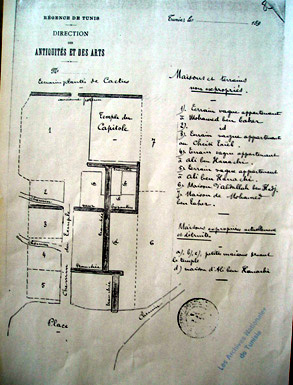 |
He also undertook excavations in front to the temple known as «Dar Lachheb».
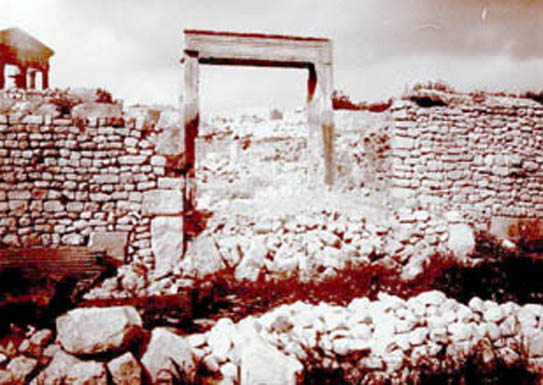 |
In 1894, Sadoux and Pradère, then curators of the Alaoui Museum (future National Bardo Museum) in Tunis, commenced excavations in the Tanit-Caelestis sanctuary, continued in 1895 by R. Coudray de la Blanchère (Director of the Antiquities Department between 1893 and 1905) and by Hilaire between 1896 and 1897.
 |
Between 1899 and 1900, Carton continued to excavate the outskirts of the theatre, which was totally cleared towards the end of the XIXth century.
 |
The time of official excavations
As from 1899, excavation campaigns in Dougga fell under the authority of the department of Antiquities and Arts in Tunis. In 1901, its director Paul Gauckler, announced that the site of Dougga was listed as an excavation site of primary importance, immediately after Carthage, and was under his direct responsibility.
1899-1900 campaign
This first excavation campaign in Dougga was entrusted to Léon Homo, student of the French school of Rome, who continued to excavate around the façade of the Tanit-Caelestis temple as well as to the south and in front of the capitol, where for the first time, he was able to identify its stairs.
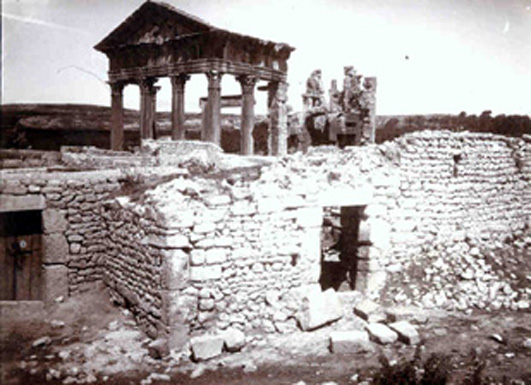 |
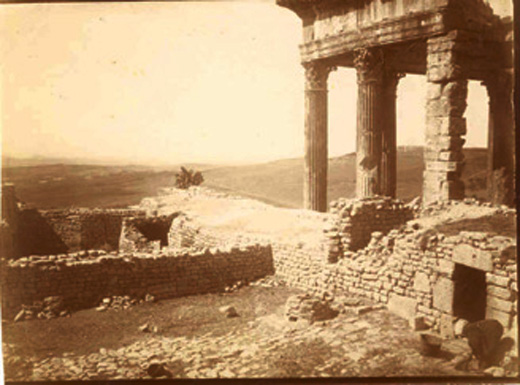 |
In the spring of 1900, Homo carried out investigations between the capitol and the arch of Severus Alexander and between the capitol and Dar Lachheb.
Alfred Merlin’s campaign
Accompanied by Louis Poinssot, responsible for epigraphy, Alfred Merlin embarked on major campaigns from May 1902. Two huge excavation sites were opened: the first around the capitol and the second encompassed the area of the anonymous temple of Dar Lachheb. Their goal was to find the forum that was then believed to lie between the two excavated buildings. Furthermore, Merlin was able to determine the extent of the columned platform. He also attempted to follow Dougga’s network of streets, looking for the street running between the capitol and Dar Lachheb.
Between October and November 1901, excavations concerned the area lying between the capitol and Dar Lachheb..
Towards the end of Spring 1902, the semi-circular exedra was finally uncovered and excavations around the forum revealed the two symmetrical towers on either side of the door of the Byzantine fortification. Other investigations carried out in the Dar Lachheb area, where the façade and the door were uncovered, led to the excavation of the houses situated to the northeast.
Continuing eastwards from the capitol during the autumn of 1902, A Merlin though he had found the forum while excavating the periphery of the Square of the Wind Rose.
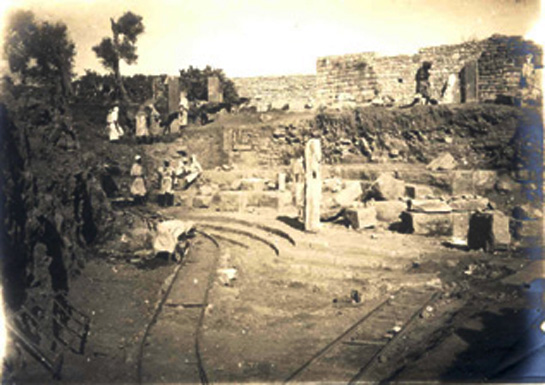 |
Then, in the western part of the site, Alexandre Bruel, a qualified French government architect, excavated the area of the arch of Septimus Severus and made investigations in the adjacent olive grove, leading to the identification of the Cyclops’ Baths and the House of the Trifolium.
Louis Poinssot ‘s campaigns
From spring 1903 and under the authority of the new director of the Department of Antiquities, Louis Poinssot, excavations and investigations were carried out in various sectors of the site.
To the east of the forum quarter, the temple of Augustan Piety and the street leading to the theatre were excavated and another site was opened to the east of the theatre
In 1904, new buildings were discovered and excavated: the temple of Mercury and the houses around the temple of Augustan Piety. The forum was then identified west of the capitol, invalidating A. Merlin’s speculations.
 |
From April to 26 May 1906, Poinssot started to excavate some of the private houses. : The villa of the Trifolium and the houses of the cupbearers and of the stairs, located to the east of the market.
The following year, the forum was partly uncovered and the exedra of Juno Regina was discovered. Between April and June of the same year (1907), excavation work concentrated on the forum.
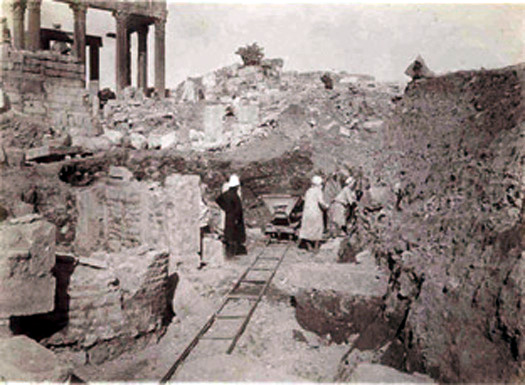 |
The most important outcome of the 1908 excavation campaign was undoubtedly the discovery, in the eastern part of the site, of the first and so far the only Christian monument, known as the Church of Victoria. In addition, during the same year, A. Merlin carried out a campaign between March and July, concentrating on the excavation of the House of the Trifolium where he was able to uncover the entrance and the courtyard.
Thanks to another campaign lasting from 26 February to 4 July 1909, L. Poinssot was able to clearly determine the plan of the forum and finish excavating the house of the Trifolium.
In 1910, excavations in the western part of the site uncovered the arch of Septimus Severus. The autumn of 1911 marked the end of excavations in the forum and the discovery of a small chapel adjoining the church. In the southern part of the site, work concentrated on excavating the ancient houses situated to the north of the Libyco-Punic mausoleum.
After a campaign lasting from 12 March to 30 July 1912, the forum was completely excavated thus revealing the general aspect of the central quarter of the city. The square in front of Dar Lachheb was entirely cleared as well as a street leaving from the northeast of the square.
During the course of 1913, excavations were carried out in various sectors. Work began on the house of the Seasons and other houses lying northeast of the temple of Mercury. Moreover, investigations carried out in the church of Victoria led to the discovery of an underground crypt. During that period, the general aspect of the Dougga ruins was repeatedly modified, especially after the demolition of modern houses built on the ancient vestiges around the capitol, which enabled a protected area around the excavated ruins to be established.
Excavation work continued in the immediate vicinity of the forum during 1914, leading to the identification of some buried buildings. The quarter bordering the temple of Mercury to the northeast was also excavated.
In 1916, excavations took place in the Temple of Tellus lasting until the autumn of the following year when a steep street climbing to the west of the theatre was uncovered.
The results of the spring 1918 campaign were as follows: identification of the apse of the market and excavation of the street descending towards the Caracalla baths (ex-Licinian baths), as well as the excavation of the temples of Concordia Frugiferi and Liberi Patris. Also, several rooms in the house of the Cupbearers and of the Stairs were uncovered. Excavations of these houses resumed in 1920.
Between 1921 and 1925, a considerable number of ancient houses were excavated by L. Poinssot and Lantier, including the house of the Birds and the one lying to the south of the temple of Tellus. As from 1927, development work of various natures was carried out on the site. Work was interrupted in 1939 because of the war and resumed only in 1954 under the authority of Claude Poinssot, son of Louis Poinssot. From then on, maintenance, restoration and development work of different kind was performed.
In fact, by reviewing the chronology of explorations on the site of Dougga, between 1903 and 1925, based on reports sent to the North African Commission, it appears that Dougga was the foremost Tunisian excavation site, in terms of time and of money allocated to it by the Department of Antiquities and Arts.
Restoration and consolidation work
At the same time as excavation work, restoration and consolidation work was carried out on several monuments
The most remarkable example undoubtedly remains the Libyco-Punic mausoleum that was almost completely destroyed in 1842 by the British consul in Tunis, Thomas Read, when he sought to remove the famous bilingual, Libyc and in Punic, inscription, at present conserved in the British Museum in London.
Between 1908 and 1910, the Department of Antiquities decided to restore the mausoleum. At the time, the monument appeared as no more than a disorderly pile of large stones. Only part of the first story was still standing.
Restoration work, carried out under the authority of L. Poinssot, consisted of sorting the stone blocks on the ground, then dividing them up between the different faces of the monument. Excavations in the area surrounding the monument also led to the discovery of further fragments that were returned to their context.
 |
The other monument to have received similar attention was the capitol. Its restoration started in 1903 under the architect E. Sadoux. At that time, only the façade portico and the end wall of the cella still remained standing.
 |
In 1903, the southwest and southeastern walls of the cella were restored. The subsequent consolidation of the whole, by L. Poinssot in 1910-1911, consisted in reinforcing the walls and the cella door and resetting the architrave and the frieze on the façade.
To the east of the capitol, the Square of the Wind Rose paving was straightened up in 1910. During the same period, the walls and the door of the temple of Mercury were restored.
Not far from the capitol, the restoration of the Anonymous temple, known as Dar Lachheb, was carried out, led by E. Sadoux in 1903. The door and the façade, still in a good state of conservation, were restored.
As for the theatre, as soon as it was totally excavated, its restoration in 1908 and 1911 consisted in putting the tiers of seats back into place and setting the stage columns upright.
Restoration work was also carried out in the temple of Tanit-Caelestis. Most of the cella columns and those of the portico were restored to their upright position in 1914. The western gate’s pillar was completely reconstituted.
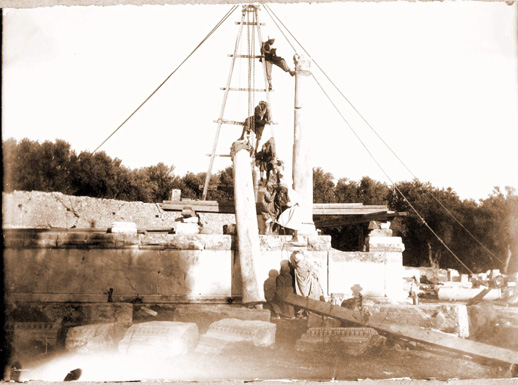 |
Later, in 1908, L. Poinssot set the niche and a part of the portico back in place. The restoration of the portico, the surrounding wall and the pillar continued in 1908 and was completed in 1914.
 |
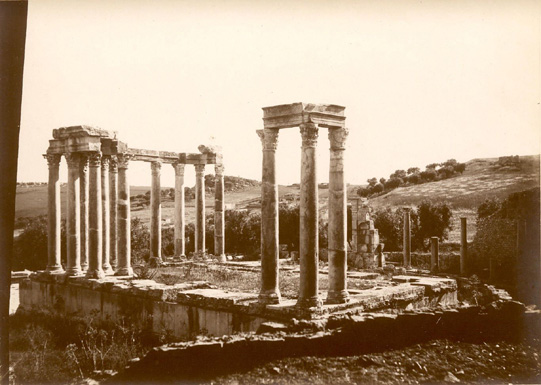 |
In the central area of the site, the portico columns of the temple of Saturn were returned to their upright position between 1908 and 1911
After Independence
After the country’s independence in 195 6, the site of Dougga came under the authority of the Institut National d’Archéologie et d’Arts (INAA, today the Institut National Du Patrimone, INP – National Heritage Institute). In 1961, the first Tunisian to have carried out excavations in Dougga was the late Mongi Boulouedine, senior INAA technician. Several buildings were uncovered between 1959 and 1962 such as the house of Venus and the Temple of Caracalla Victories.
Dougga National Archaeological Park in 1991: a new phase in the conservation and development of the site.
The 21st July 1991 is a landmark date for Dougga: on that day, during a cabinet meeting in Carthage, chaired by the Head of State, the decision was taken to turn the site of Dougga into a National Archaeological Park. To this end, a vast inventory and study programme was launched.
1- The PETRAE-Thugga: programme started in1993, and consisted in making an inventory of and studying the epigraphic texts of Thugga. In this context, two major works were published: Dougga fragments d’histoire. Choix d’innscriptions latines éditées, traduites et commentées (Ie-IVe siècles) (Dougga fragments of history. Choice of Latininscriptions edited, translated and commented(1st –IVth centuries)in 2000and Mourir à Dougga, Recueil des inscriptions funéraires (To die in Dougga, Collection of funerary inscriptions) in 2002. This programme was carried out in cooperation between the National Heritage Institute and the AUSONIUS centre of the University of Bordeaux III. It was led by Mustapha Knanoussi, research director at the INP and Louis Maurin, Professor emeritus of the University of Bordeaux III.
2- The «Pagan religious architecture Thugga» Programme started in 1999 and concerned the study of pagan religious architecture in Thugga. Several religious buildings were studied within the context of this project: the capitol, the temple of Caelestis, the temple of Caracalla’s Germanic Victory, the temple of Pluto, the temple of Mercury..
The programme was carried out in cooperation with the two above mentioned institutions and led by Mustapha Khanoussi and J.-Cl. Golvin, research director at CNRS.
Dougga, Heritage of Humanity
Witnesses to more than seventeen centuries of the history of a small provincial town, the vestiges of Dougga are considered, for their diversity and beauty, amongst the most spectacular not only of Tunisia, but of the whole Maghreb. Since December 1997 they are inscribed on UNESCO’S World Heritage List.
Dougga is also amongst the five archaeological sites of Mediterranean countries included in the Euro-Mediterranean project PISA, a pilot project for the management and development of archaeological heritage.
Collections
Mosaics
The Cyclops forging Jupiter’s thunderbolts
 |
Dating to the end of the IIIrd century AD, this mosaic was found in the Cyclops’ Baths, thus giving its name to the establishment.
The mosaic measures 4.74m x 3.30m and figures the three Cyclopes Brontes, Steropes and Pyracmon inside a rocky cave. Their bodies are naked and damp with sweat and they are forging Jupiter’s thunderbolts that Vulcan, seated opposite them, is holding on the anvil. One of the cyclops’ legs, destroyed to mid height, was restored during antiquity in a very clumsy manner.
The mosaic is at present displayed in the National Bardo Museum.
The victorious auriga
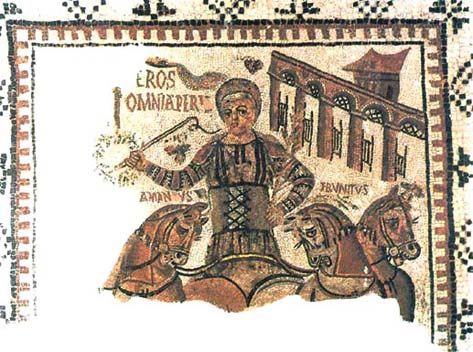 |
Discovered between Dar-Lachheb and the Capitol, the mosaic can be assigned to the end of the IVth century AD and is now displayed in the National Bardo Museum.
It represents a victorious Auriga standing in a quadriga. His name is Eros and he is cracking his whip with his right hand while carrying a crown and a palm. To his left figures the acclamation: Eros omniaper te (Eros, all thanks to you)
The names of two out of the four horses are figured: Amandus et Frunitus (the amiable and the jovial).
In the background, five arcades closed by swinging openwork doors represent the circus stables.
Cupbearers
 |
Discovered in the house of the Cupbearers, thereby giving the house its name, the mosaic is datable to the IIIrd century AD. It measures 1.90m x 3.50 and represents two large cupbearers carrying amphorae on their shoulders. They are serving guests with wine. On the amphora of the right-hand cupbearer, adorned with ivy leaves, the Greek word PIE (Drink) is written in Latin characters. On that of the left-hand cupbearer, the work ZHCHC(You shall live) is written in Greek. The two wishes are complementary: (Drink and you shall live). Two young waiters, on the left and right of the picture, bring the drinkers, one, a basket of flowers, the other a napkin and a small amphora probably containing perfume. The mosaic is now exhibited in the National Bardo Museum.
Swimmer and Neirids
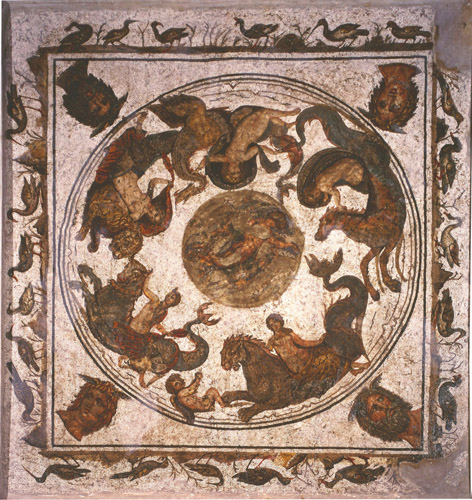 |
Measuring 3mx 3m and datable to the late IInd century AD, this mosaic figures a swimmer surrounded by five Neirids astride marine monsters. It is framed by a border representing birds walking or pecking. The heads of the four winds occupy the corners of the picture.
The four circus factions
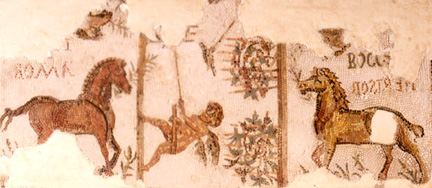 |
Datable to the second half of the IVth century AD, this mosaic is at present exhibited in the National Bardo Museum
Measuring 1.25m x 0.55m, it represents the horses of the four circus factions pictured two by two facing each other and each with a palm of victory. The racehorses, two of which are almost entirely destroyed – are accompanied by their names: Derisor and Bocc[hus],Amor et … ri(?).
Putti hunting birds with birdlime are figured amongst the vines whose branches are made to twine on hoops. Only one of the putti still exists.
Epitaph of Vitellius Crispinus
This tombstone mosaic measuring 1.25 x 0.55m presents the epitaph of the child Vitellius Crispinus who died aged eight. Discovered in a hypogeum, it is now displayed in the National Bardo Museum.
Epitaph of Quintus Papirius Fortunatianus
Discovered in a hypogeum, this tombstone mosaic of a child is datable to the IVth century AD. It measures 0, 90m x 1, 90m and portrays the deceased seated on a sort of coffer probably suggesting a sarcophagus. An epitaph figures on either side of the deceased’s head.
D(ii) M(anibus) S(acrum)
Summa(e) bonitatis et ingeni puer, Q(uintus) Papiri(u)s Fortunatianus Eusebius vix(it) an…
To the gods Manes, consecration
A child of extreme goodness and intelligence, Quintus Papirius Fortunatianus Eusebius lived (so many years).
The remainder of the mosaic is occupied by four branches of roses, spikes of wheat, vine and olive branches, symbolizing the four seasons. It is at present displayed in the National Bardo Museum.
The three masks
Discovered in the house of the Three masks the mosaic measures 3m, 30 x 1m, 80. It figures medallions each enclosing a different subject: two masks of Bacchantes, a mask of Silenus, various birds. It can be assigned to the early IIIrd century and today is exhibited in the National Bardo Museum.
 |
The victorious Auriga on foot
 |
Discovered in a house in the quarter of the Caracalla Baths, this mosaic is at present displayed in the National Bardo Museum. Datable to the late IVth century AD, it portrays, in a circular medallion, an auriga standing in frontal view brandishing a whip in his right hand and holding a palm, symbol of victory, in his left hand. Horses from a quadriga figure enclosed in rectangles. The racehorses are heavy and squat and look rather like ponies. .
Putti
Discovered in a house south of the temple of Tellus, this mosaic measures 1m, 90 x 1m, 39. It figures a large gold crater from which two vines laden with grapes fall out. Two putti are busy amidst the branches. The one on the right is standing, with a basket on his shoulder full of bunches of grapes. The second is portrayed seated on a branch holding a pruning knife in one hand and a leash in the other. Datable to the end of the IVth century AD, this mosaic is at present displayed in the National Bardo Museum.
«May everything bring you luck»
Found in the house known as t Omnia tibi felicia and datable to the IVth century AD, this mosaic is now on display in the National Bardo Museum. It lent the house its name for in the centre of a laurel wreath can be read the words of welcome Omnia tibi felica (May everything bring you luck). Ivy leaves with a prophylactic value are figured on the ground and in the corners. It measures 1m x 10 1m, 10.
Marsyas
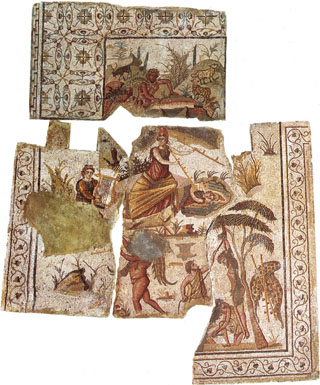 |
Discovered in the « house of Marsyas » this mosaic is now in the site storeroom. It represents the various episodes of the legend of the shepherd Marsyas who dared to challenge the god of music Apollo in a contest : the discovery of the double flute by the goddess Athena and Marsyas surprising her, the musical contest between Apollo and Marsyas and the punishment of the shepherd. It is datable to the IVth century AD.
Labyrinth
 |
Discovered in the house to which it gave its name, this mosaic measures about 5m x 5m. It figures a geometric maze suggesting the plan of a labyrinth. The walls of the monument, portrayed in a conventional manner, are suggested by corner towers and fortified gates. It is datable to the IIIrd century AD and is now exhibited in the National Bardo Museum. .
Birds and an Ibex
 |
Datable to the IIIrd century AD, this mosaic was discovered in the house of the labyrinth. It is now displayed in the National Bardo Museum.
Measuring 2m, 78 x 2m, 75, it figures vine scrolls laid out in a grid of tangent circles and squares. The circles contain birds and the squares ibexes. Hexagonal medallions figure between these compartments containing stalks of laurel forming diamond shapes and containing fleurons.
Masks and white dove
Discovered in the house of the trifolium, this mosaic is datable to the second half of the IIIrd century AD
Within a hexagonal medallion figures a racehorse (mutilated) advancing towards the left. All around, six circular medallions picture various motifs : two tragic masks, a comic mask, an amphora, bunches of grapes and a white dove perched on a rose branch. Two ivy leaves figure in the intervals and shells in the corner.
The mosaic is at present displayed in the National Bardo Museum. It measures 2m, 15 x 2m, 15.
The gazelle Bodala
 |
Discovered in the house of the trifolium, the mosaic is now on display in the National Bardo Museum. It is datable to the IIIrd century AD and measures 0, 95m x 1m.
It pictures a tame gazelle named Bodala wearing a collar around its neck. The animal’s head is almost entirely missing.
Dionysos
 |
Found in the house of Dionysos and Ulysses, this mosaic is now displayed in the National Bardo Museum. It represents, within a circular medallion, an adolescent Dionysos reclining on a tiger. He is naked with a veil floating above his head, holding a crater in one hand and a thyrsus in the other. All around, eight small rectangles contain alternatively a Satyr or a Bacchante carrying various attributes. One of the Bacchantes is figured reclining. Measuring 4m.75 square, this mosaic is datable to the mid IIIrd century AD.
Pecking bird
Discovered in the house of Dionysos and Ulysses, this mosaic is today displayed in the National Bardo Museum
Datable to the late IIIrd century AD, it pictures octagons containing an evolute spiral band and by a laurel wreath surrounding a bird pecking at a plant. Squares and trapezes respectively enclose, fleurons and demi-fleurons. It measures 3m, 28 x 2m, 65.
Fishing scenes
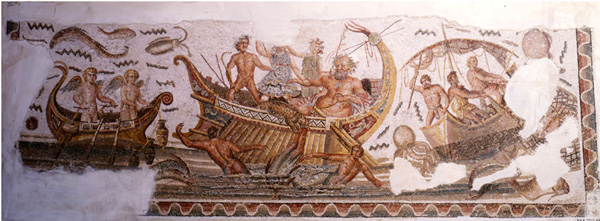 |
Discovered in the house of Dionysos and Ulysses, this mosaic measures 3m, 85 x 1m, 40. In the centre figures Dionysos as an adolescent dressed in a short tunic, standing in a boat and holding a lance in his right hand. A Satyr-mentor, a Bacchante and the old Silenus busy manoeuvring the rudder-oar accompany the god
Two boats are pictured on either side. The right-hand boat contains three figures: two are pulling up a large net full of fish and the other is fishing a big octopus with a harpoon. Aboard the second boat, situated to the left, are two putti, one holding the oars, the other pulling up basket traps.
Datable to the reign of Gallien (260-268 AD), this mosaic is now displayed in the National Bardo Museum
Ulysses resisting the song of the Sirens
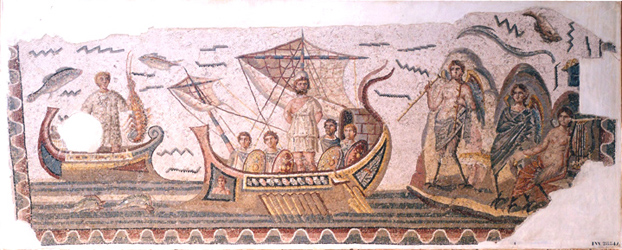 |
Discovered in the house of Dionysos and Ulysses, the mosaic measures 3m, 50 x 1m, 40. A boat with two sails is figured in the centre with Ulysses, wearing a bonnet and dressed in a white tunic, unhitched on the right shoulder. His hands are tied to the tall mast to prevent him from falling under the fatal charm of the Sirens’ music. Four companions are sitting around him, armed with shields. To the left of the picture is a boat containing a fisherman holding up a large lobster. .
The three Sirens are figured to the right of the boat. They are pictured with a female bust, winged and with birds’ feet . The first, on the left, is portrayed standing and holding a double flute. The middle one is seated and is probably singing because she is not holding an instrument. The third is also figured sitting holding a lyre in her left hand.
Datable to the reign of emperor Gallien, this mosaic is now displayed in the National Bardo Museum
Fishing scenes
 |
Discovered in the house of Dionysos and Ulysses, this mosaic measures 3m x 1m, 03.
A muscular fisherman is figured in the centre of the mosaic. He is busy pushing a rowboat into the water containing rope and a hook and line.
Another fisherman is portrayed to the left of this scene. His knee resting on a rock, he is piercing a big octopus with a trident. Another fisherman figures on the other side, carrying a basket on his back and just about to throw a net on some fish.
Fishing scenes
 |
Discovered in the house of Dionysos and Ulysses, this mosaic measures 2m, 97 x 1m, 03. It figures a fisherman in a rowboat in the centre. He is about to throw a heavy anchor into the water. To the left and right of this scene, on the coastline, two fishermen are sitting on the rocks: one is repairing a net and the other, wearing a straw hat and equipped with a basket, is holding a line that a fish has just bit. Datable to the reign of emperor Gallien (260-268 AD), it is now exhibited in the National Bardo Museum.
Fish and crustaceans
 |
This semi-circular shaped mosaic figures fish, crustaceans and molluscs. It was discovered in the house of Dionysos and Ulysses. Measuring 2m, 65 x 1m, 80, it is at present displayed in the National Bardo Museum. It dates back to the reign of emperor Gallien (260-268 AD ).
Dionysos and the seasons
 |
Discovered in the house of Dionysos and Ulysses, this mosaic is datable to the mid IIIrd century AD. It measures 3m, 15 x 3m, 82.
Within a circular medallion bordered by a laurel wreath, it figures a bust of Dionysos surrounded by four other medallions. These are delimited by drapery and contain the female busts of the Seasons, their heads crowned with their characteristic vegetal attributes.
The mosaic is at present displayed in the National Bardo Museum.
A museum of full air
 |
When one arrives by north, one sees by far only the abrupt cliff which constituted a natural defense, as well as the columns of the frontage of the temple of Baal Hamon-Saturne(n°1) which, after work of restoration of the beginning of last century, dominate their found height the valley of the Khallad wadi. On the other hand, if one arrives by the south, it is a sight of the whole of the site which is offered to the visitor. A sight which leaves dreamer. Vestiges staged in terraces, dominated by the majestic masses of the temple of Capitole (n°12), the public thermal baths known as of Caracalla (n°21) and of the theatre (n°5). How then not to remember with which vanity, which joy and which sorrow, of the generations of men and women, any origin and any culture confused, contributed to the construction of these monuments become ruins? These ruins are consisted of the vestiges of public monuments, as well religious as profane, as well as remainders of the private residences. First of all let us mention the Saturn temple (n°1) built at the end of IIe century after J-C with the site of an older sanctuary which goes up at the time pre-Roman and who was devoted to the worship of Baal Hamon, the large god of punic Carthage. It is composed of three cellae giving on a large court surrounded by gantries. Downwards, a necropolis extended pagan (n°4) which is remained in service during many centuries, until after the triumph of the Christian religion, as testify the funerary vault to it to a rich person family where the incineration and the burial were practised in turn and the small church AD memoriam which was built with the Life century and which to date remains the only Christian building cultuel found in Dougga. Then, the theatre (n°5) comes. Majestic building of semicircular form arranged to hillside and whose construction required significant earthworks and a considerable sum of ingeniousness and technical prowesses. Its capacity estimated at approximately 3500 places for a population of 5000 people (10000 if one counts those which resided on the territory) largely exceeded the real needs for the city. After nearly fifteen centuries of abandonment, this monument was exhumed, its restored vestiges, and took again service. For more than fifty years, each summer, it has again accomodated the large crowd of the amateurs of cultural leisures which the spectacles of the International Festival of Dougga attract. In his “eternal residence”, the generous giver who, a long ago, financed his construction, should be only more to trust of his realization. Let us continue our walk and borrow the ancient street which leaves the theatre and moves towards the west, towards the center of the ancient city. Its layout, curved like that of all the other streets of the city, recalls that the city at the time Roman had an urban screen which is remained fundamentally numide. Its beautiful pavement and the sewer which runs below reflects the influence of Roman civilization. More which was added to him was the monumental ornament with the Roman whose city was equipped little by little thanks to the generosity of the rich person citizens resulting from the two communities indigenous and Roman and within the framework of the emulation and the race to the honors of the easy families. When one arrives at the district of the forum which constituted the heart of the city, one is in front of one seizing shortened long history of Thugga. Regarded a long time as being of Roman foundation, but to which recent research has just allotted an origin much older, this district constitutes a faithful mirror which reflects in a condensed way the various times of the history of the city. The many monuments that one finds there constitute in fact of the witnesses of the multiple refitting and alteration work of which it was the object. Four of them can in this respect being regarded as emblematic each one of a great period: – the temple of Massinissa (n°14) for the royal period numide, – the temple of Capitole (n°12) for the Roman imperial period, – the fortification (n°16) built with materials of re-employment taken in older monuments become useless for the period byzantine – and, for the Islamic period, of the small thermal baths of time aglabite(n°17) and especially, on the substructions of a pagan sanctuary, a small mosque (n°8), only rescapé monument of the agricultural hamlet which for a long time lived on and in the ruins of the ancient city.
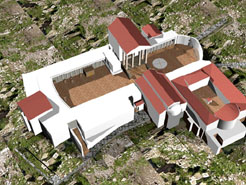 |
District of the forum, the visitor has only the embarrassment of the choice to continue the visit. It can reconsider its steps and move towards the East to go to visit the religious complex (n°22) single in its kind and composed of temples with which one is equipped with a small theatre cultuel which was arranged on the debris of levels of habitat of the time numide. This unit which was built under the reign of the emperor Hadrian (118-138) by members of the one of the families more for the city, that of Gabinii, is separate only by one paved lane of a white mosaic of the large public thermal baths (n°21) built under the reign of Caracalla (211-217 after J-C). The construction of this hydropathic establishment should not have been of any rest as the three levels testify some to the monument: – level of access of the users consisted by the mosaïquée lane and the hall – level of use which one reaches by the staircase which connects the hall to the various parts of the establishment – level of service located under the heated part of the establishment and consisted the undergrounds which were borrowed by the personnel charged to supply the hearths out of wooden and to make heat water. Or, it can continue towards the west and go to visit an anonymous pagan temple said Dar Lachheb (n°30) which was considered for a long time and without any valid reason a market of slaves, the house of Venus (n°31) and the temple of the Victories of Caracalla (n°32) which is contiguous for him. A little further, towards the west, in the medium of olive-trees centenaires, are the sanctuary of Tanit-Caelestis (34) in the single semicircular plan in its kind in the pagan religious architecture of all North Africa. Not far from there, towards the North-East, one meets the vestiges of the public cisterns of Aïn el-Hammam (n°35) and the arc with a bay of Severe Alexandre (n°37), and further still towards north, the cisterns of Aïn Mizeb (n°38), the temple of Minerve (n°39), the circus (n°40) and the necropolis dolmenic (n°41). The walk can end in the visit of the low districts of the city where are the libyco-punic mausoleum (n°54) that significant work of restoration gave in state at the beginning of last century as well as the vestiges of many private residences: house of duck and the seasons (n°46), house of the tifolium (n°48), house of Gorgone (n°51)…
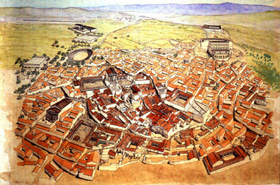 |
Share this content:
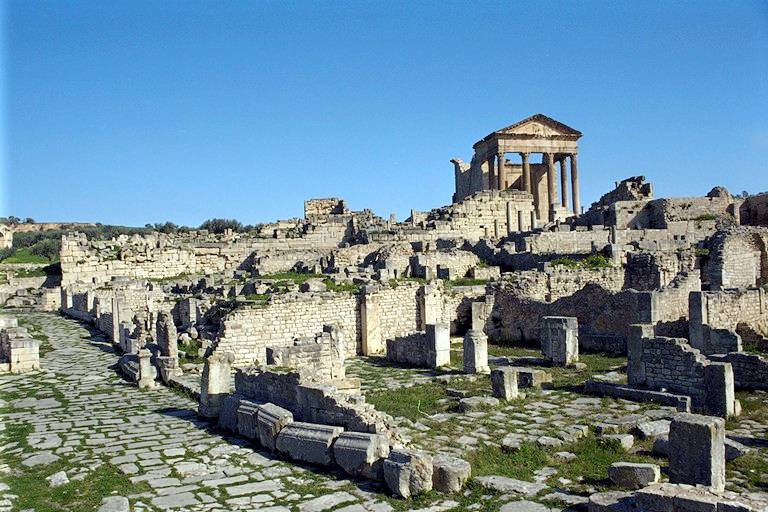
Leave a Reply